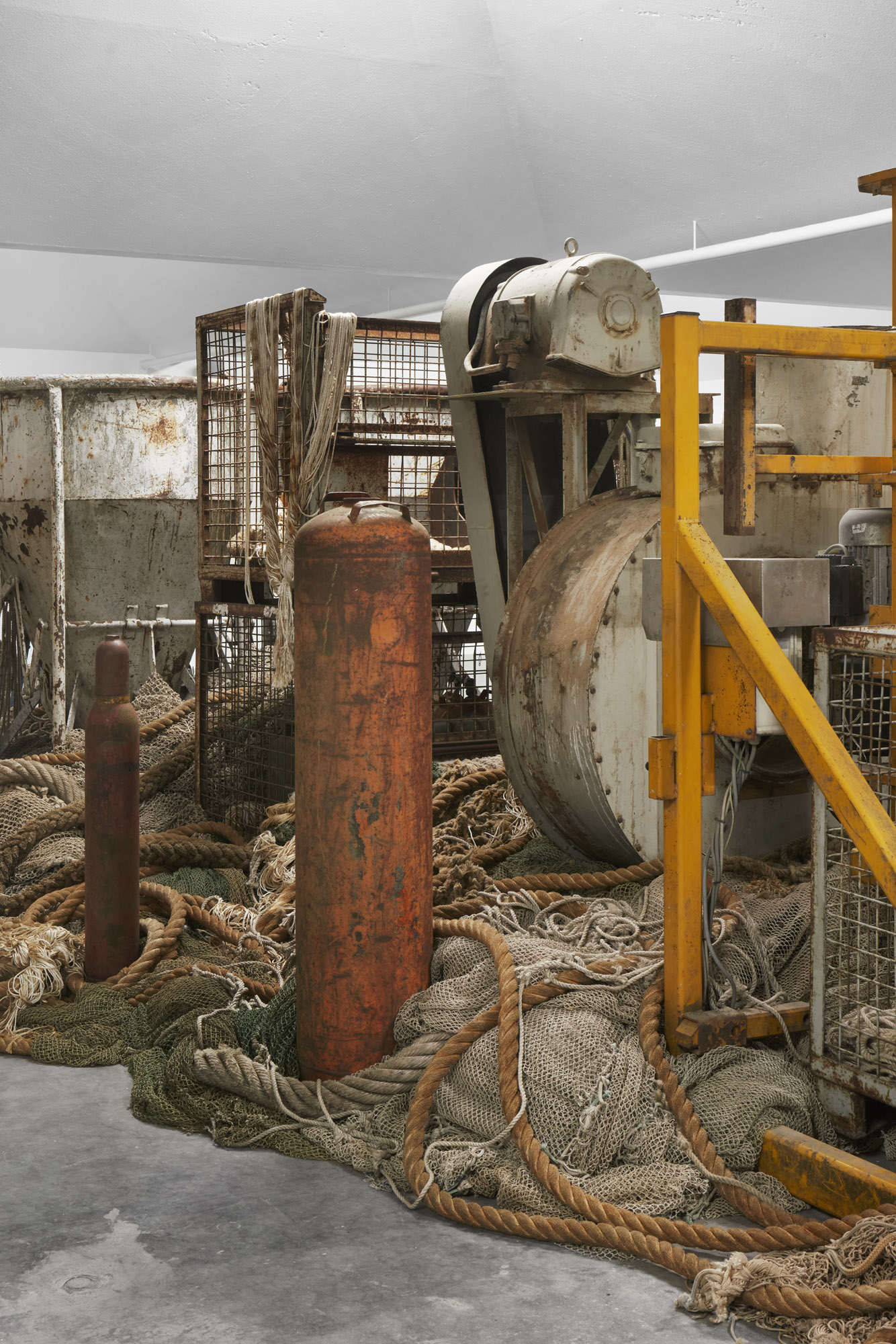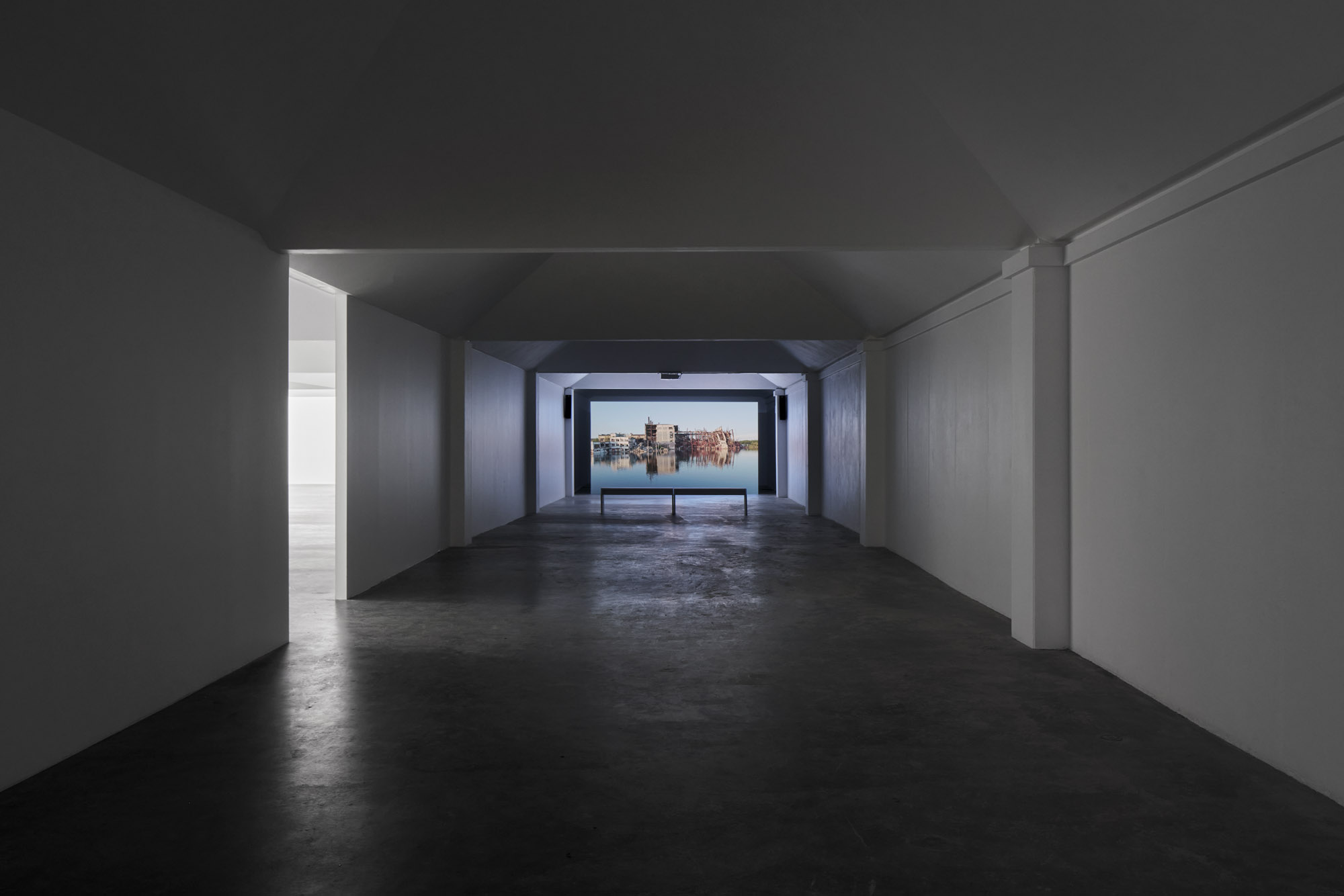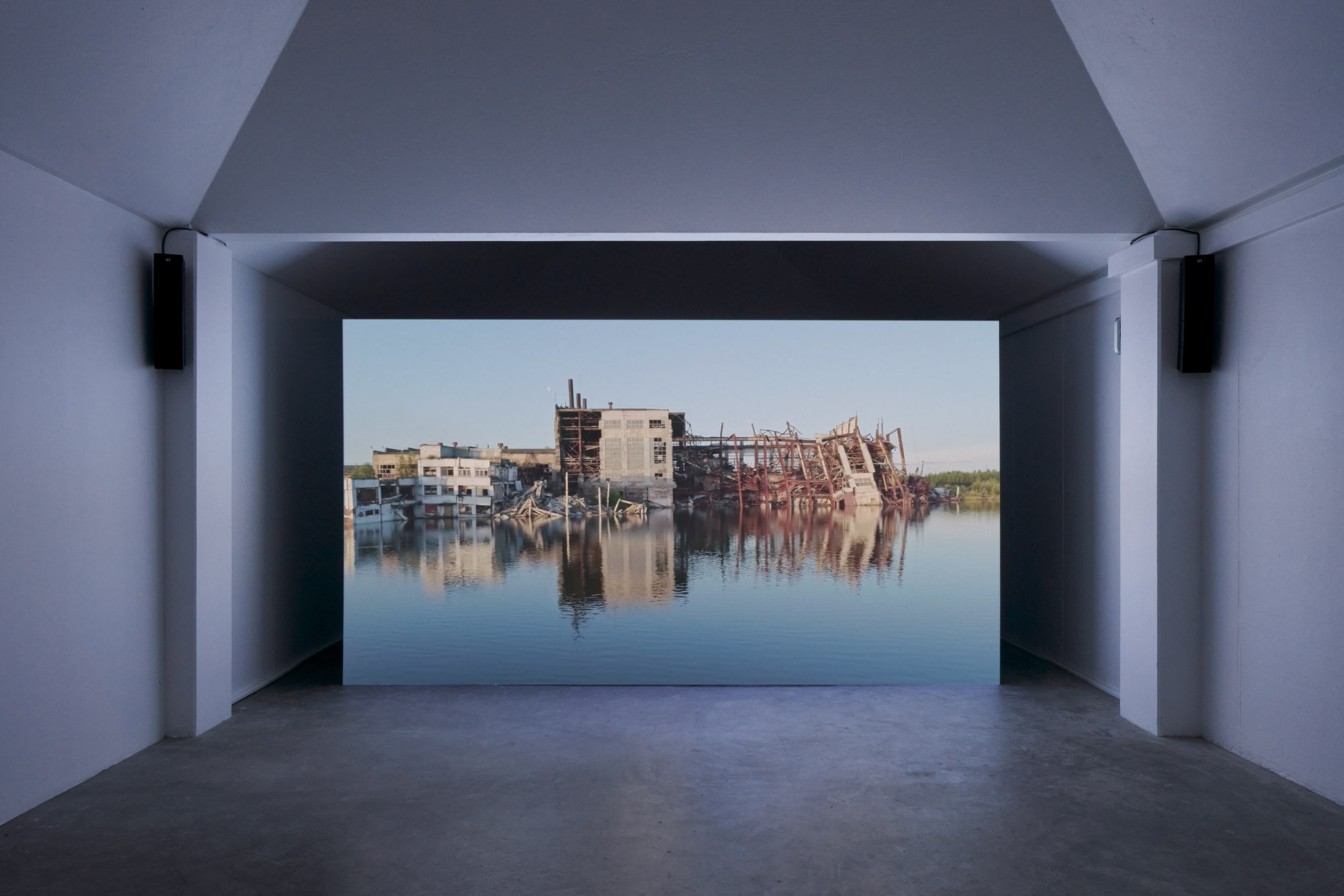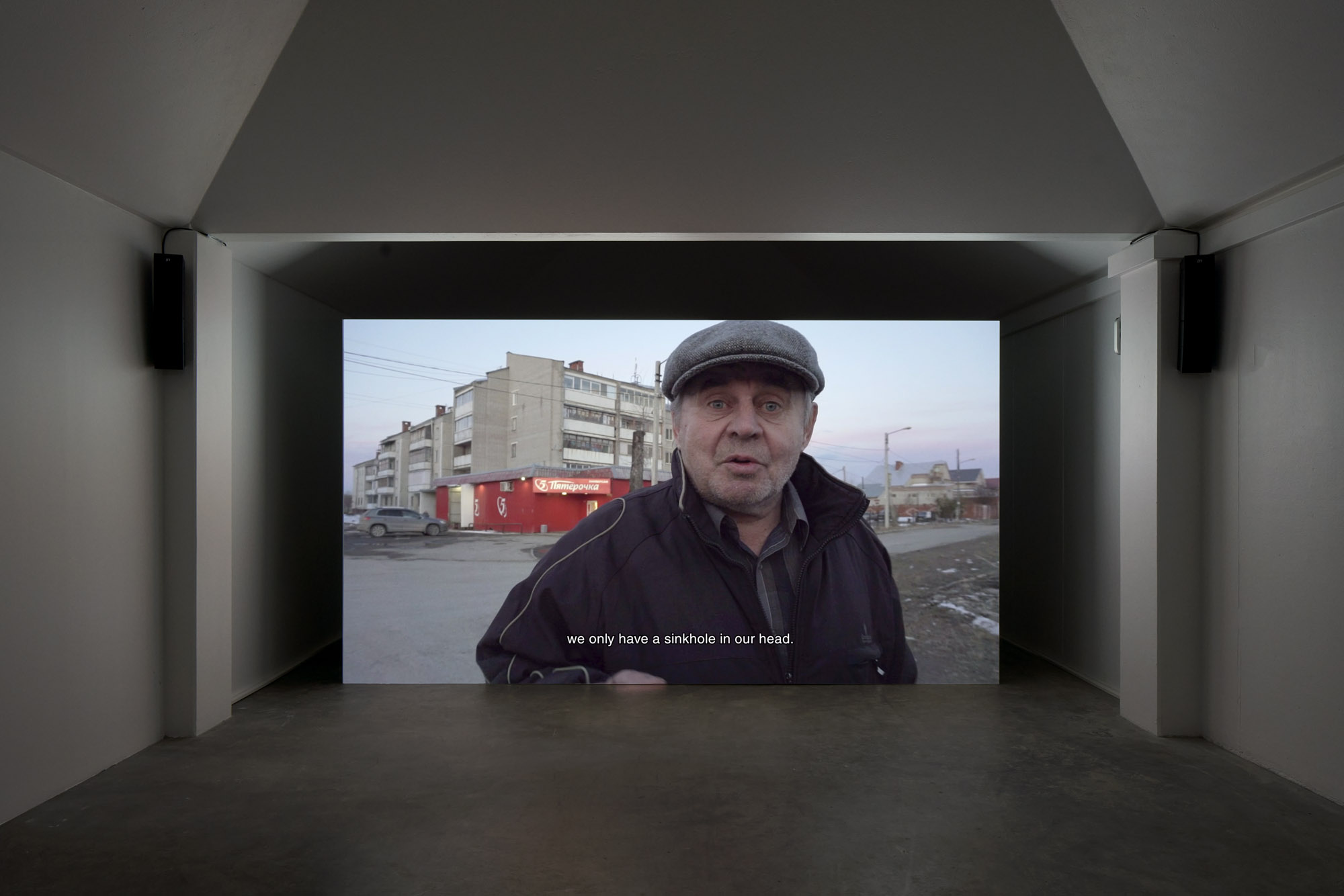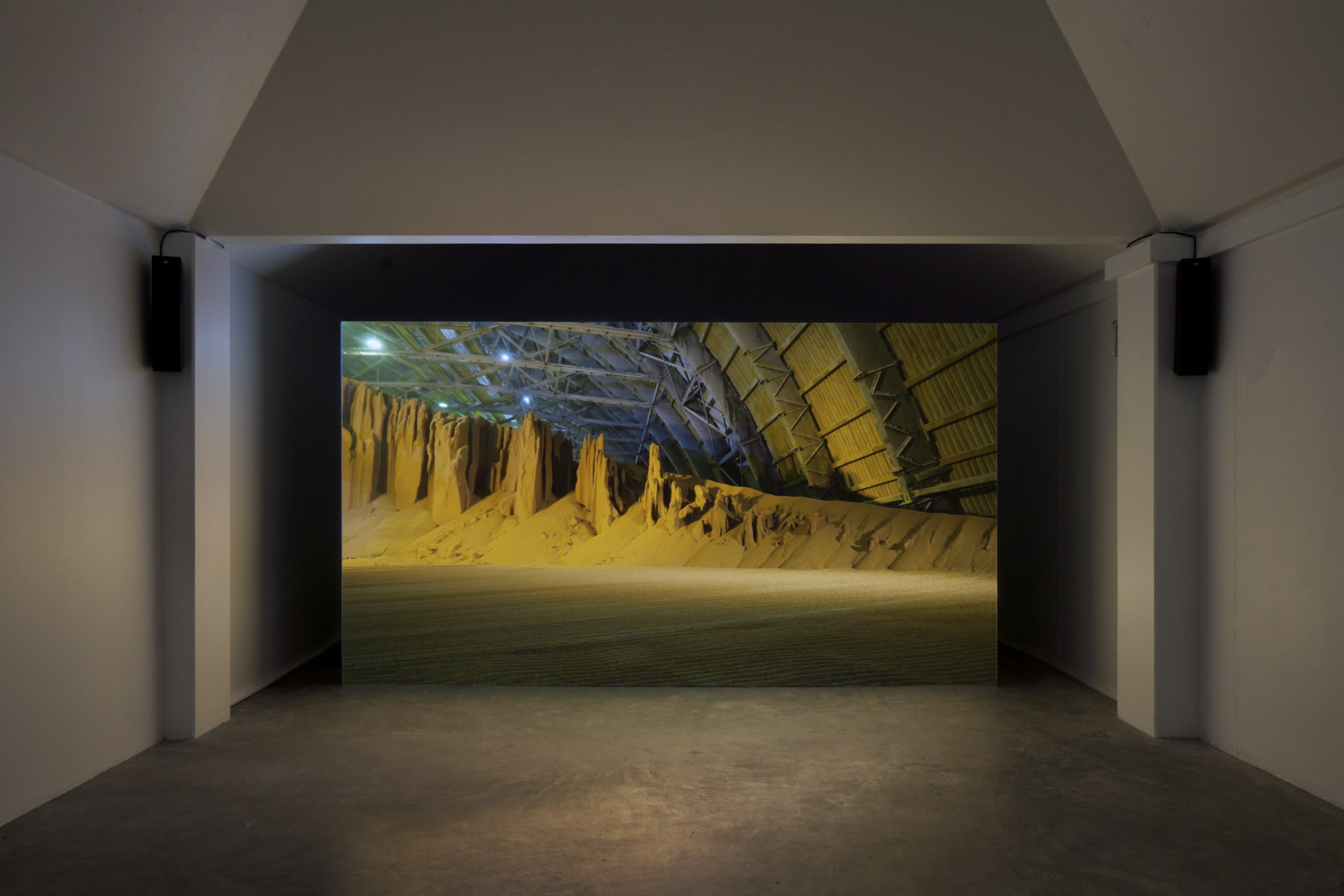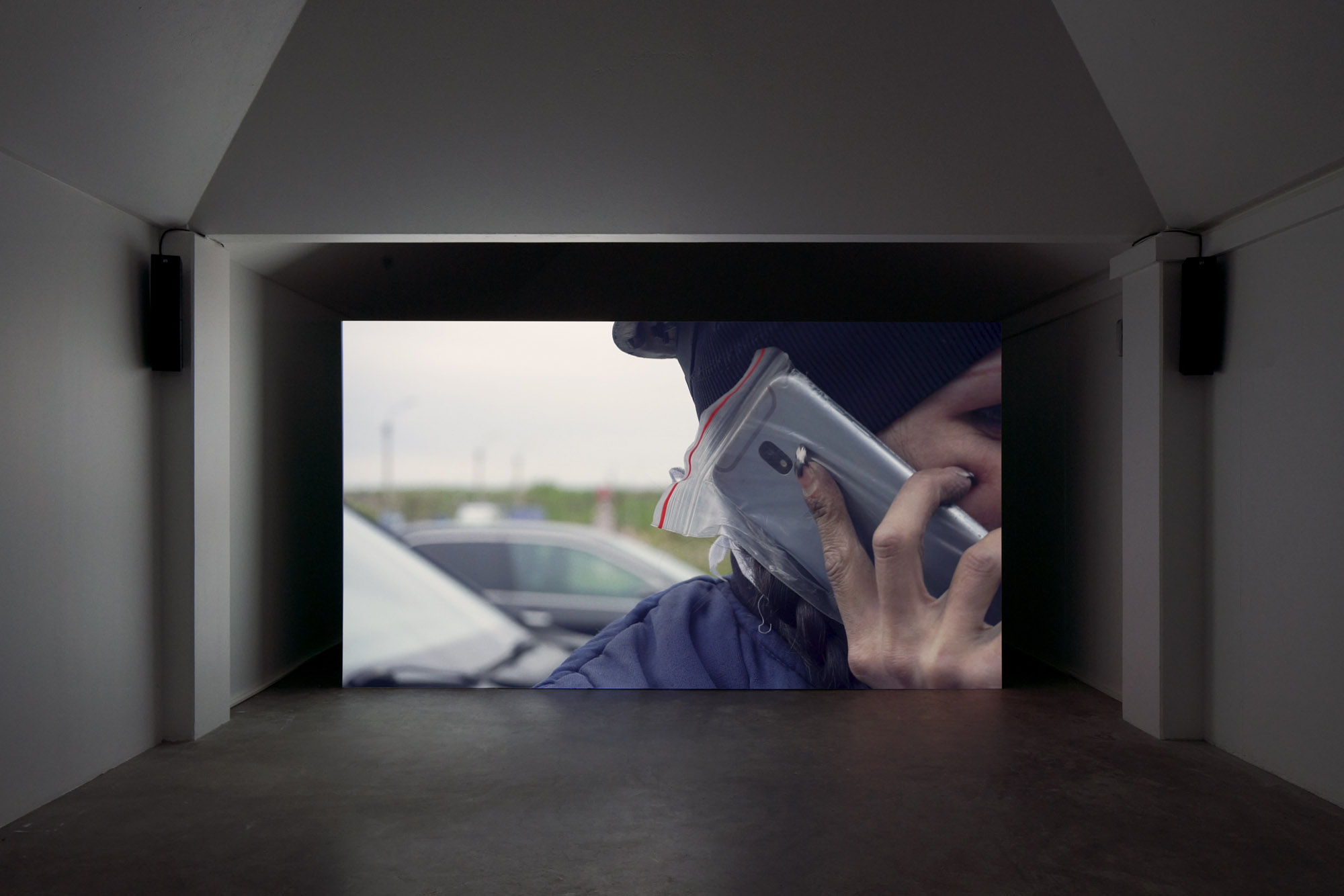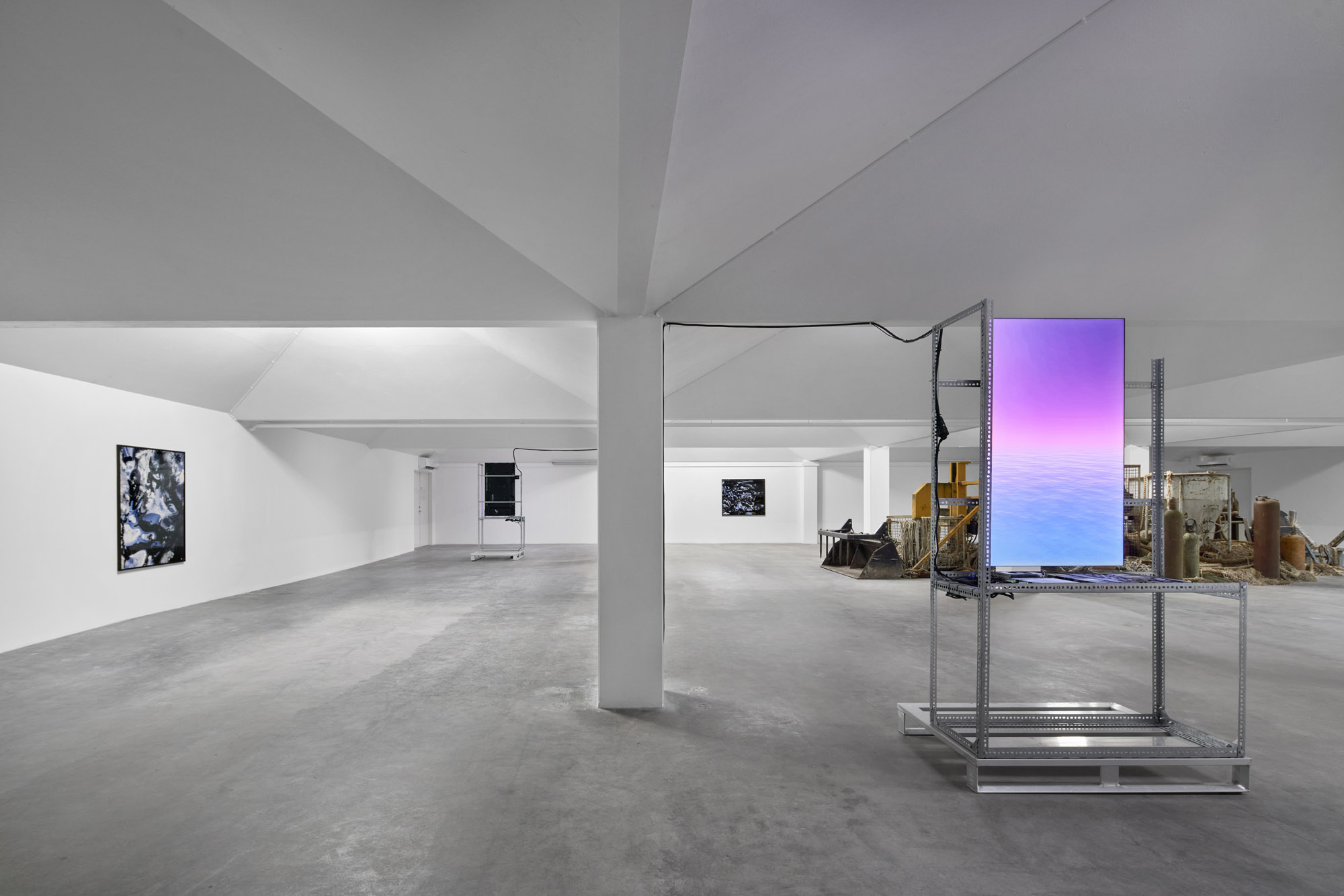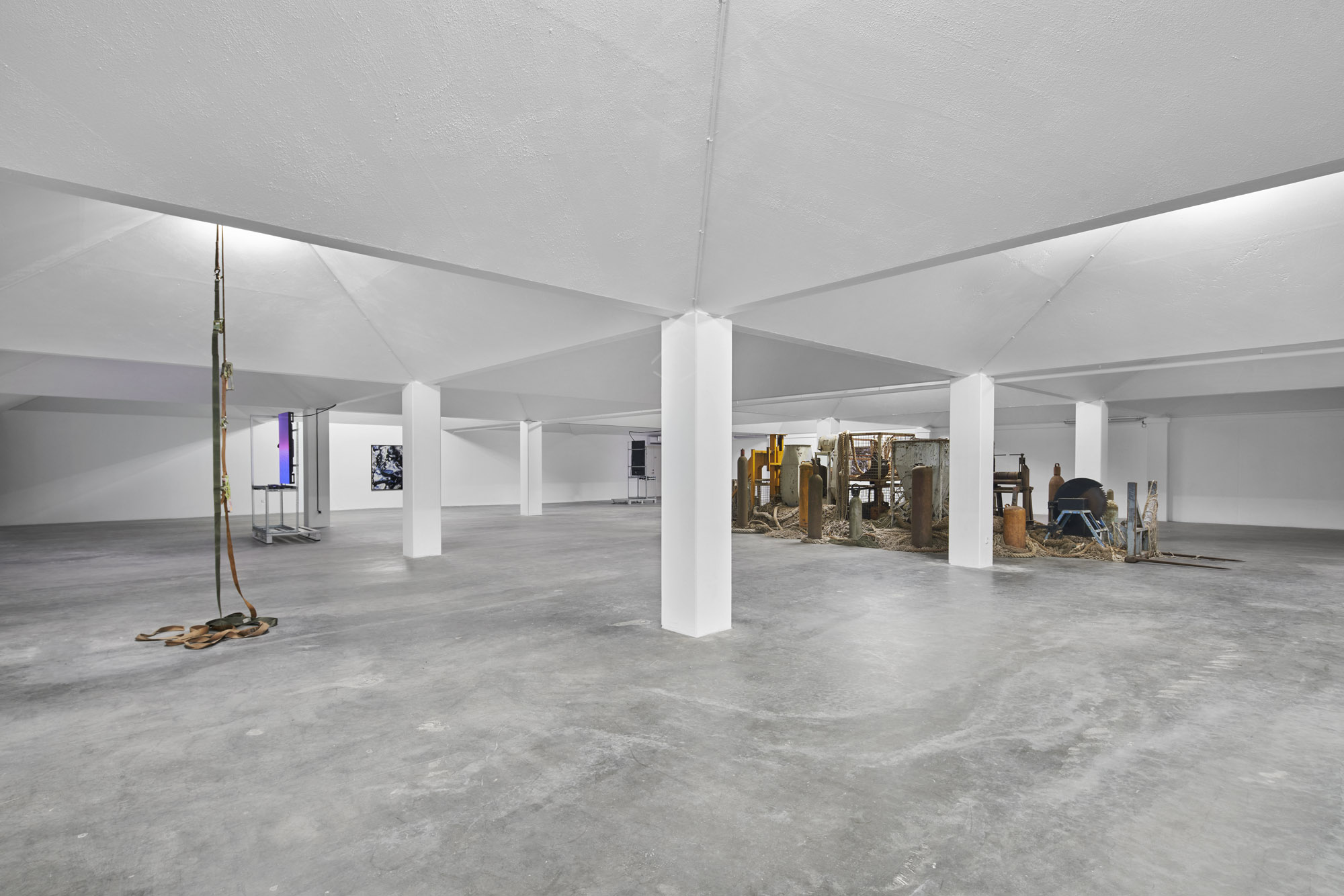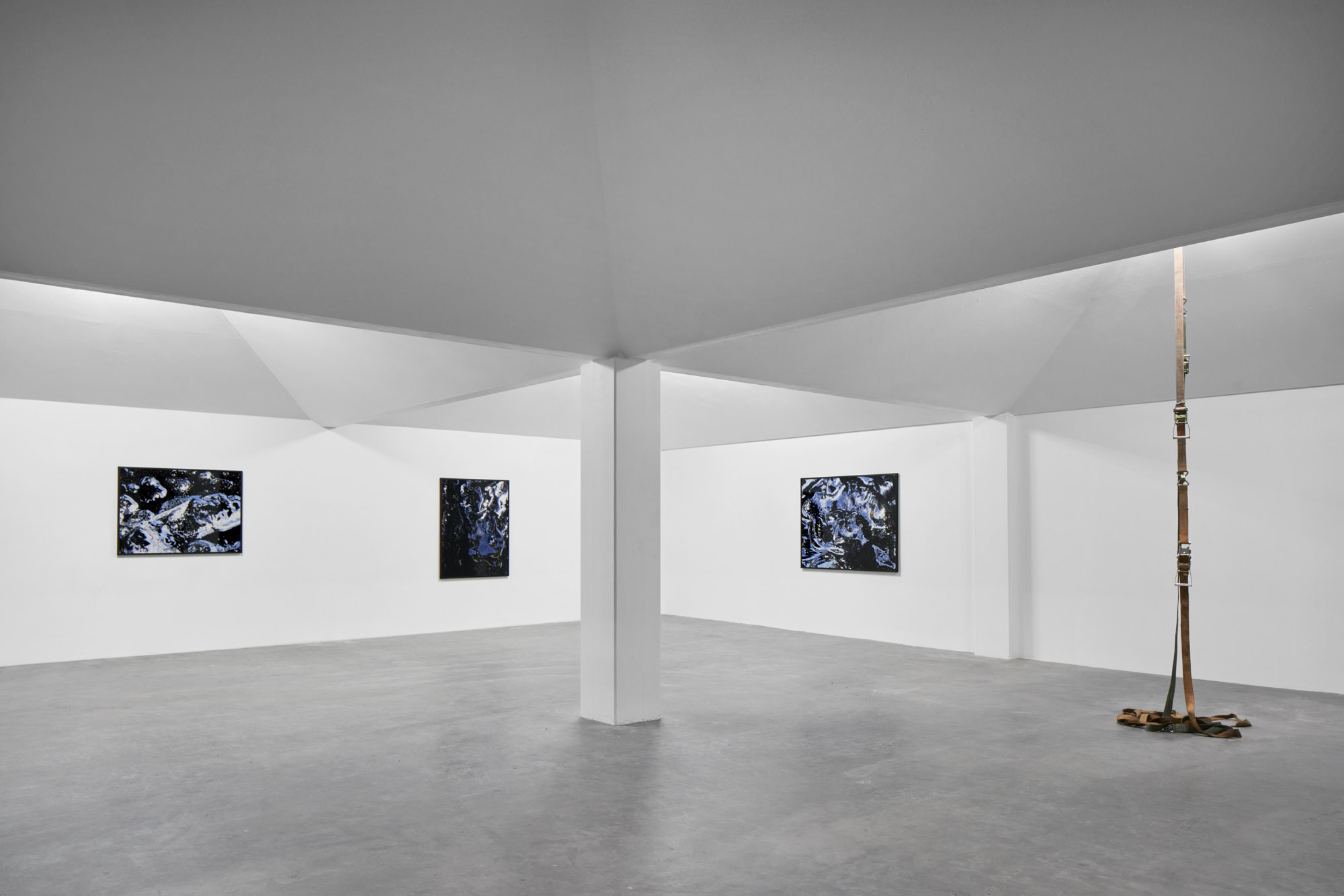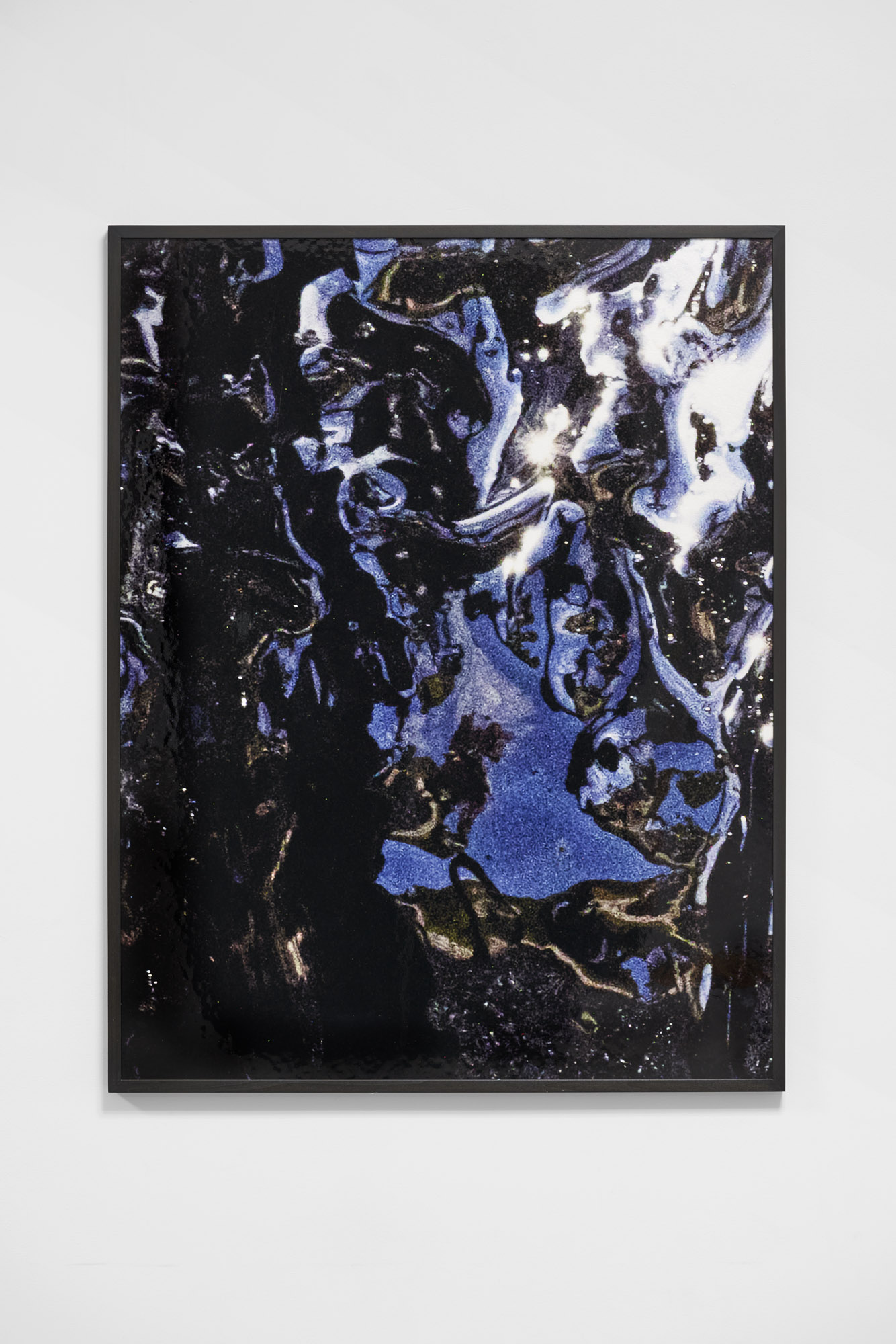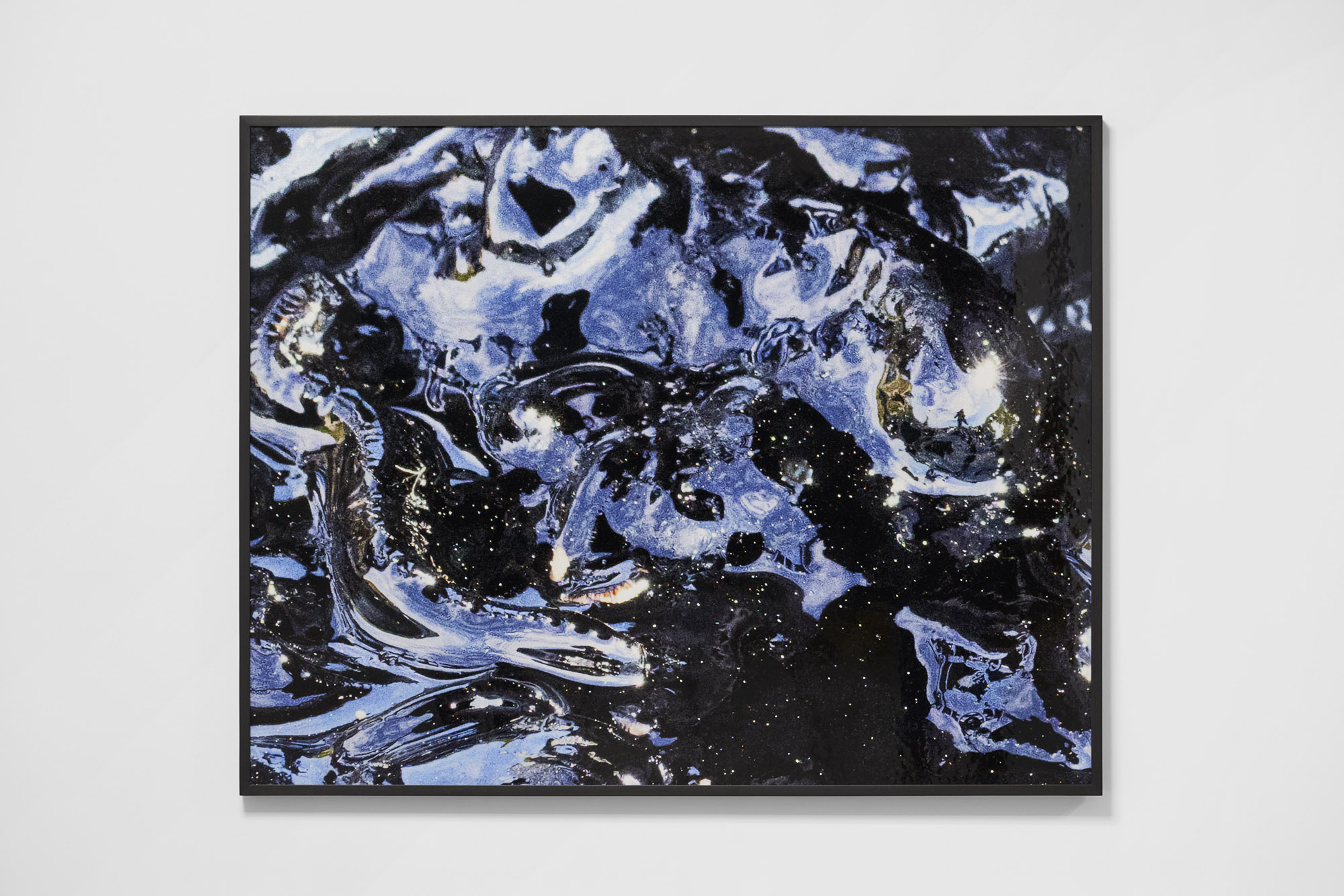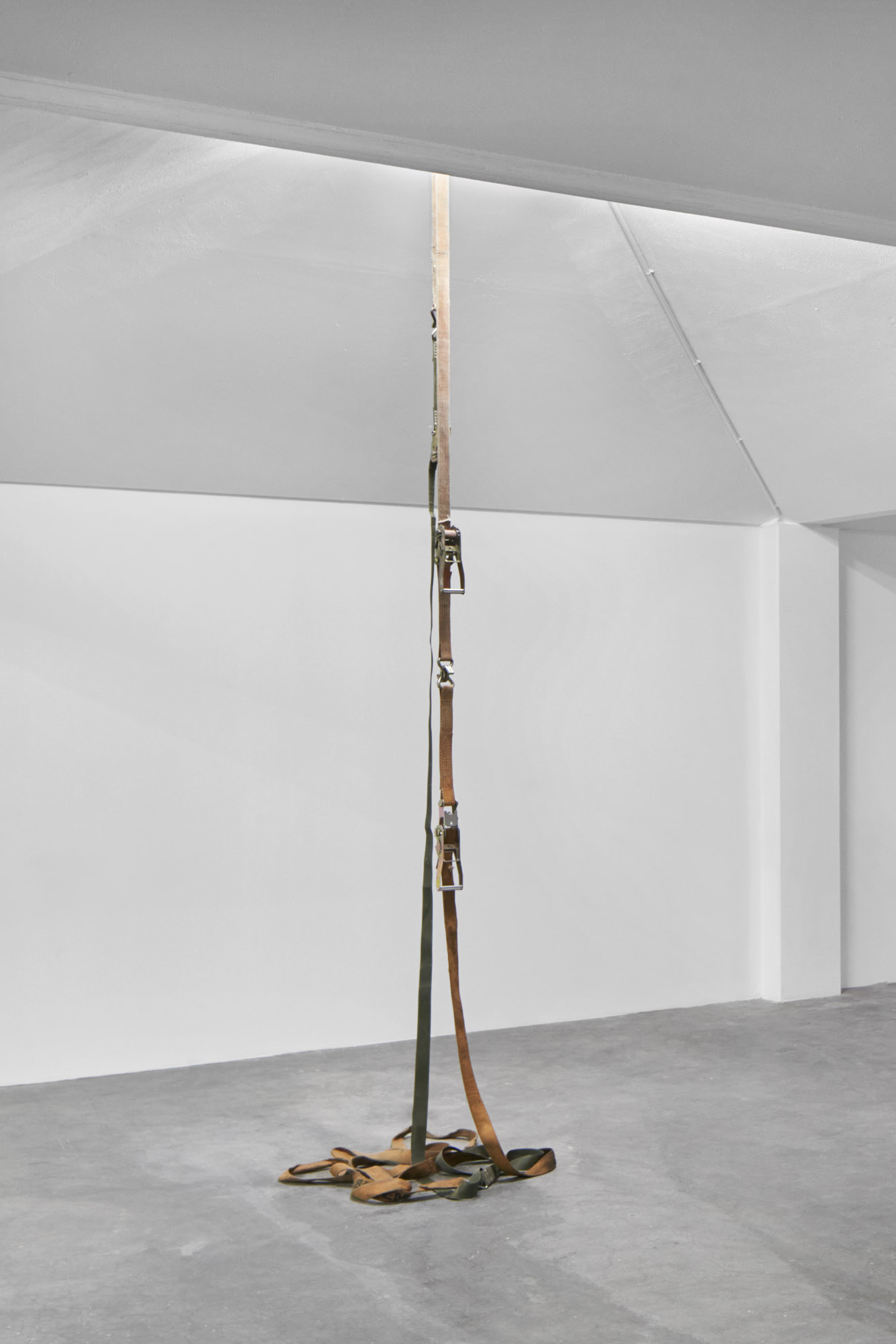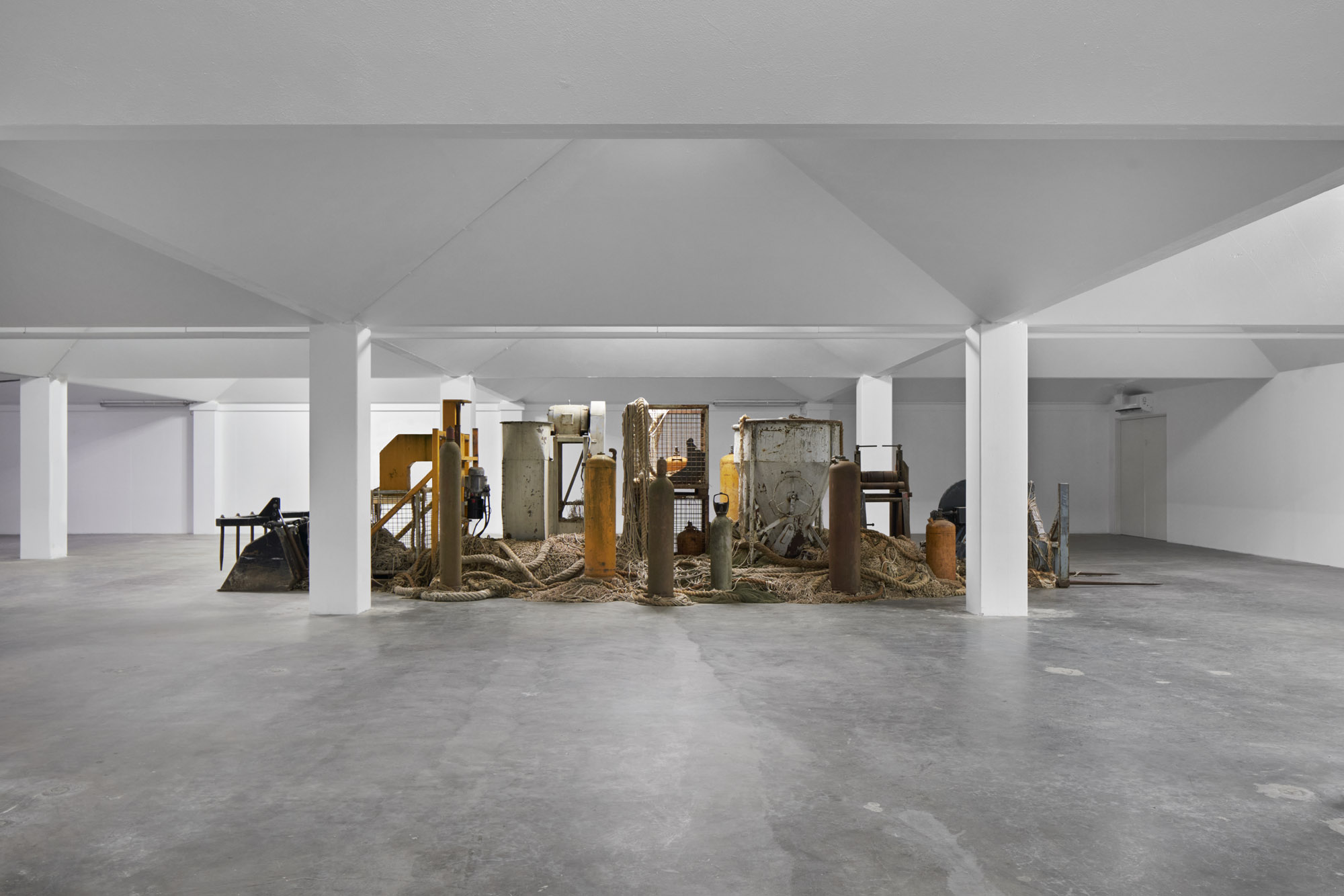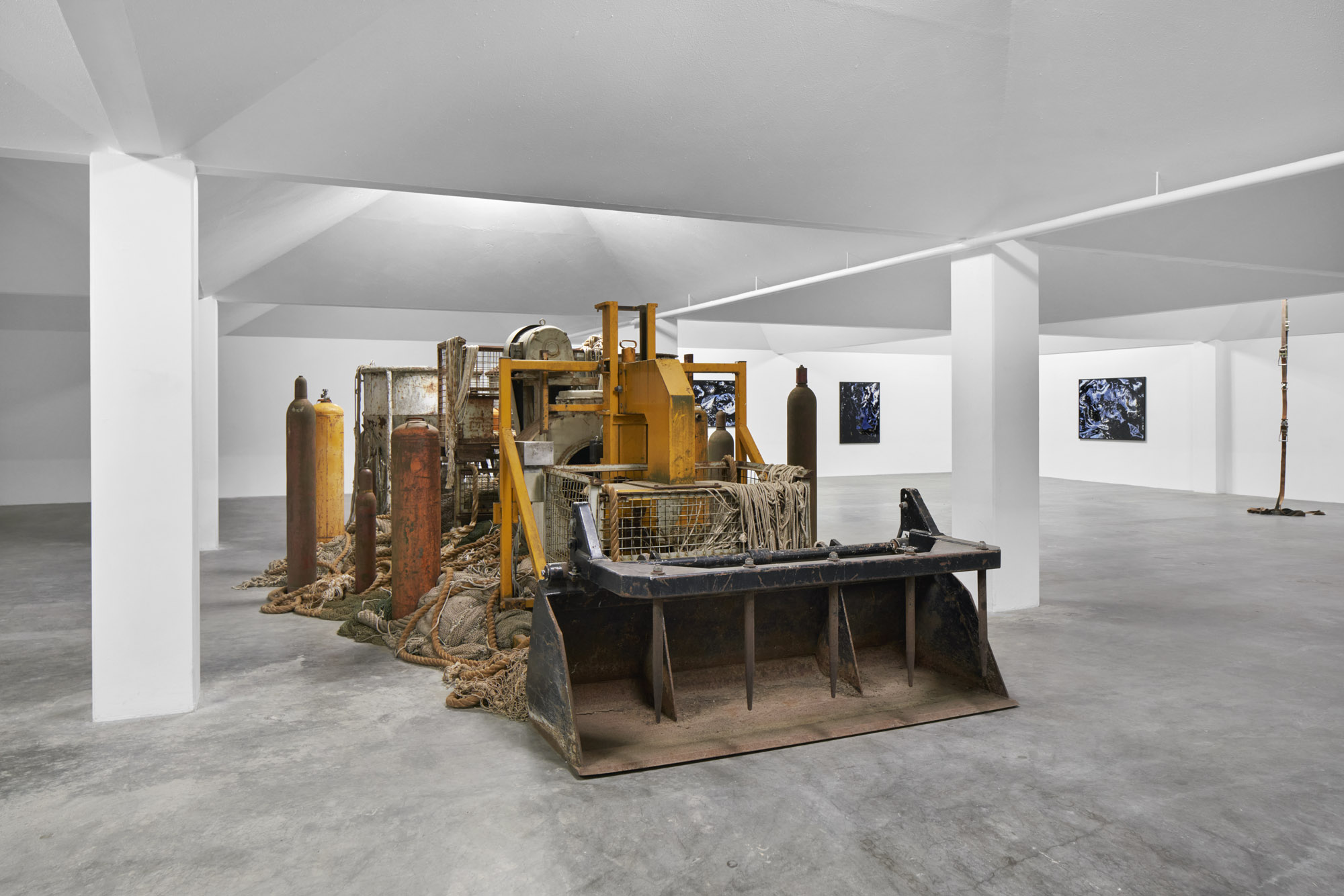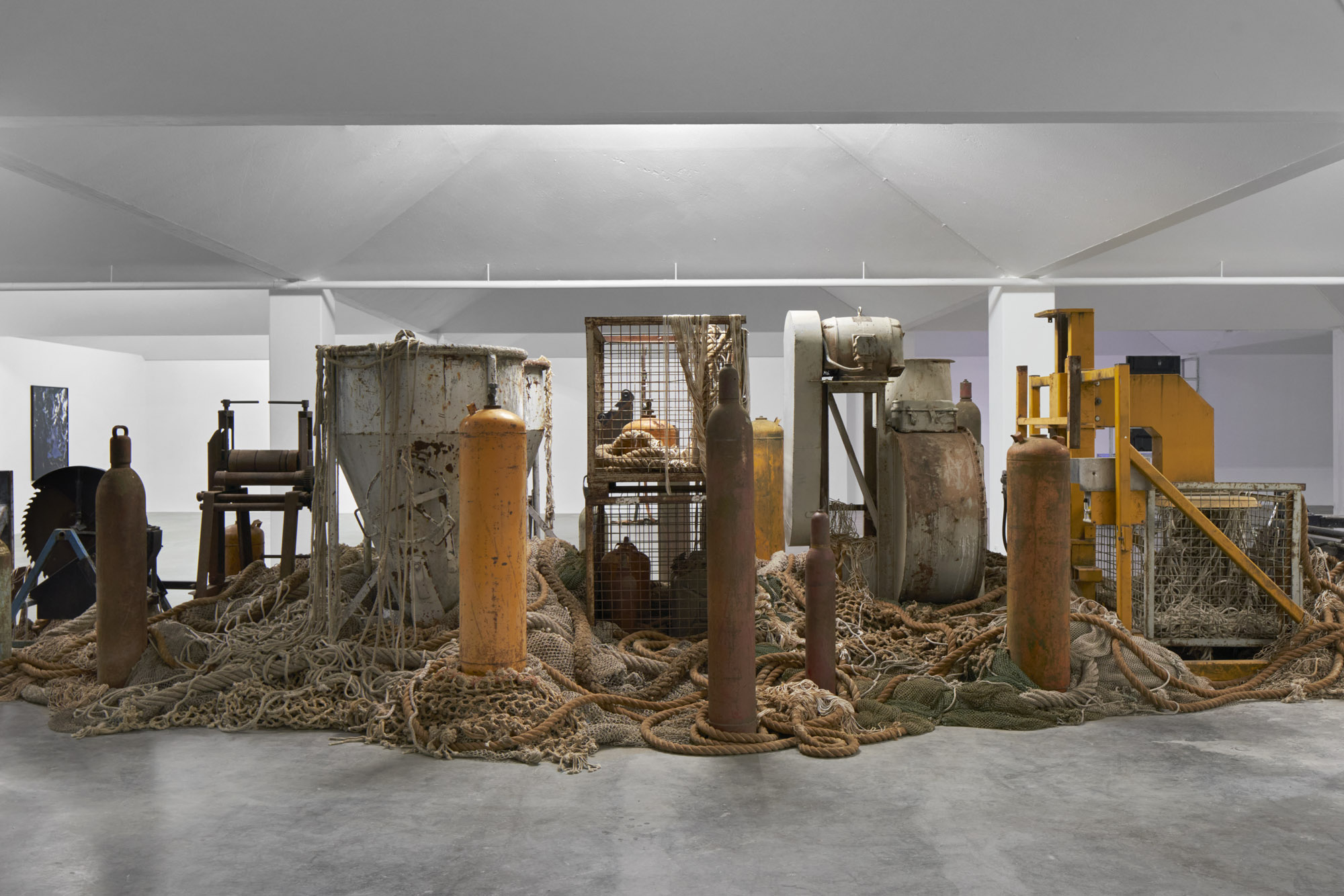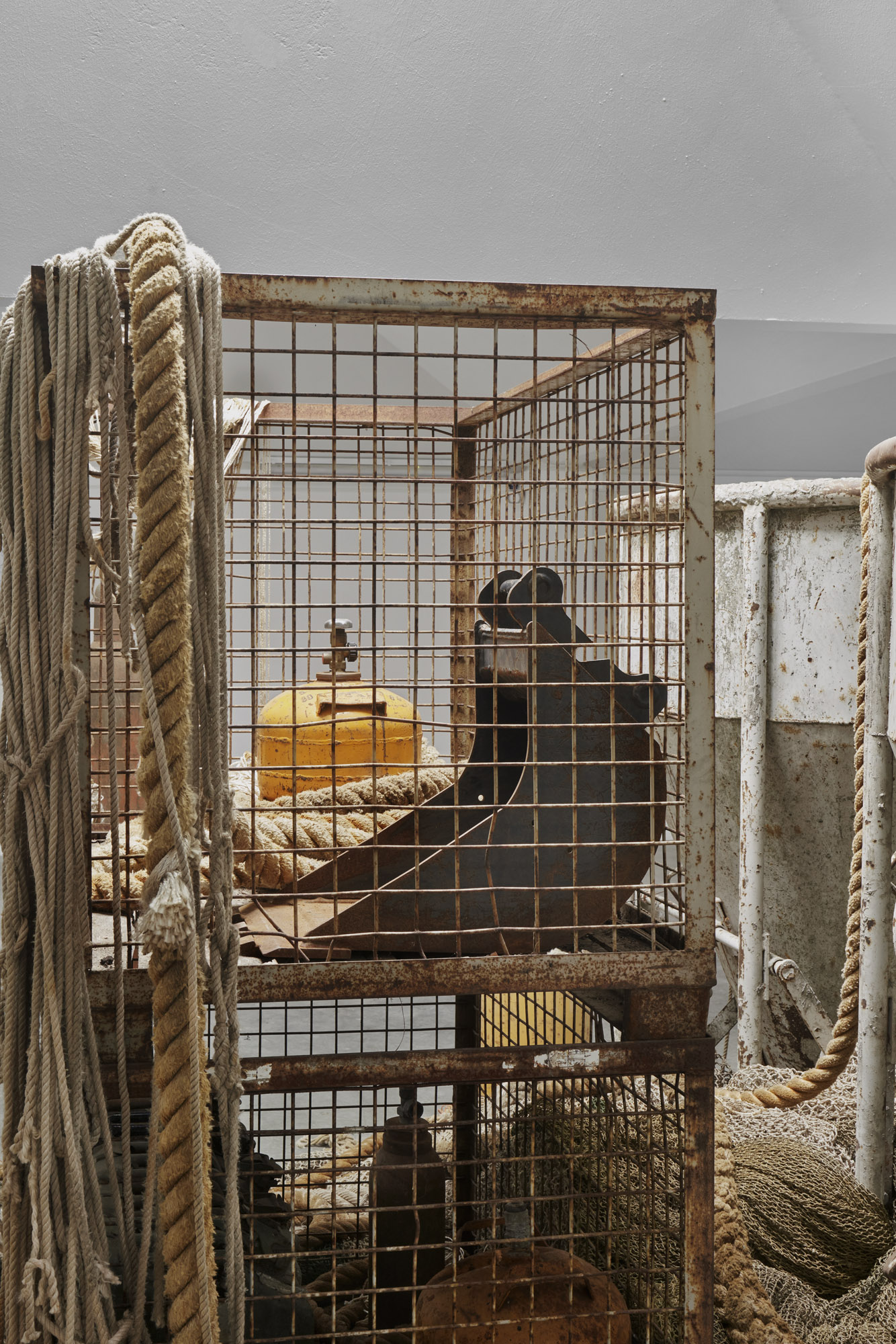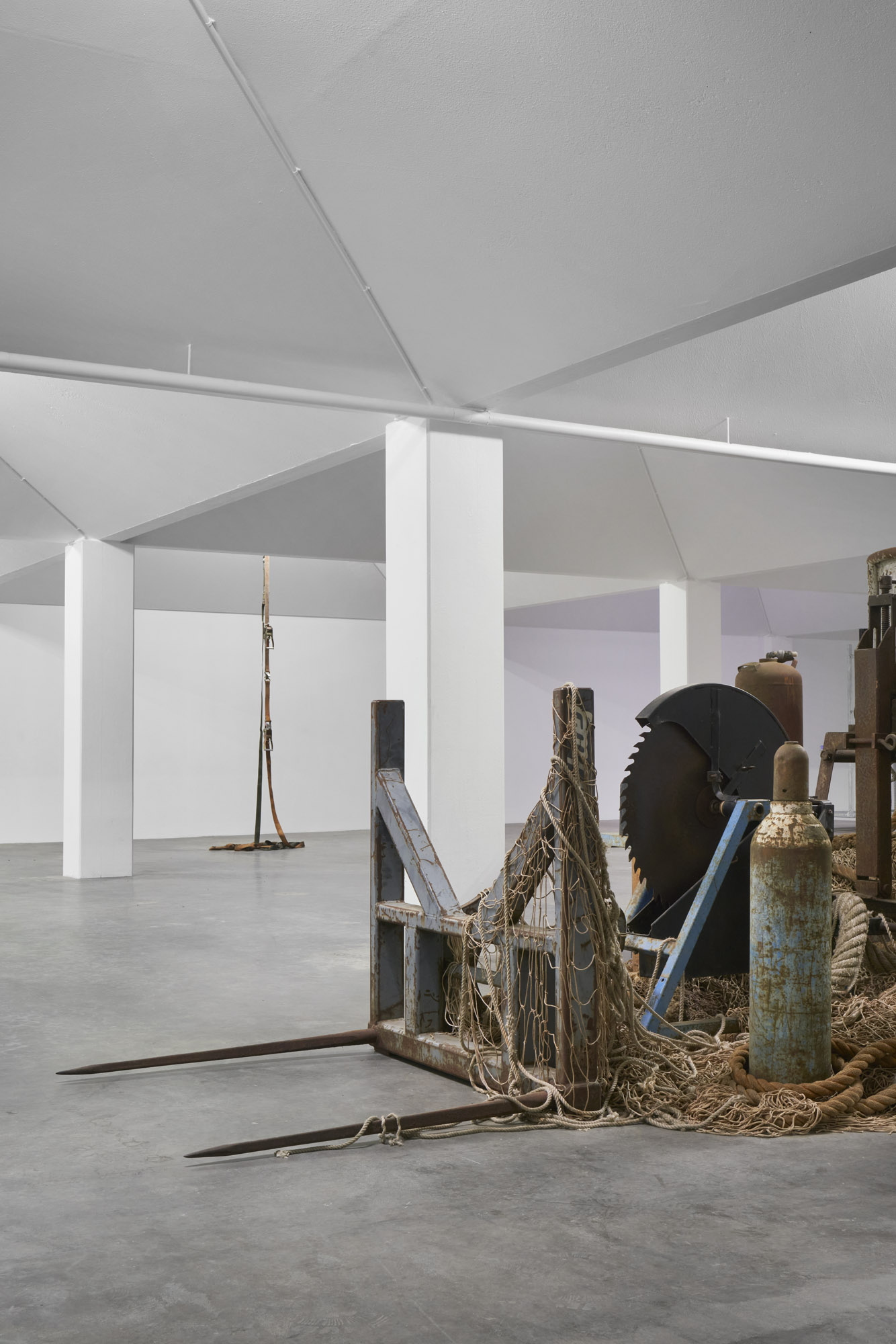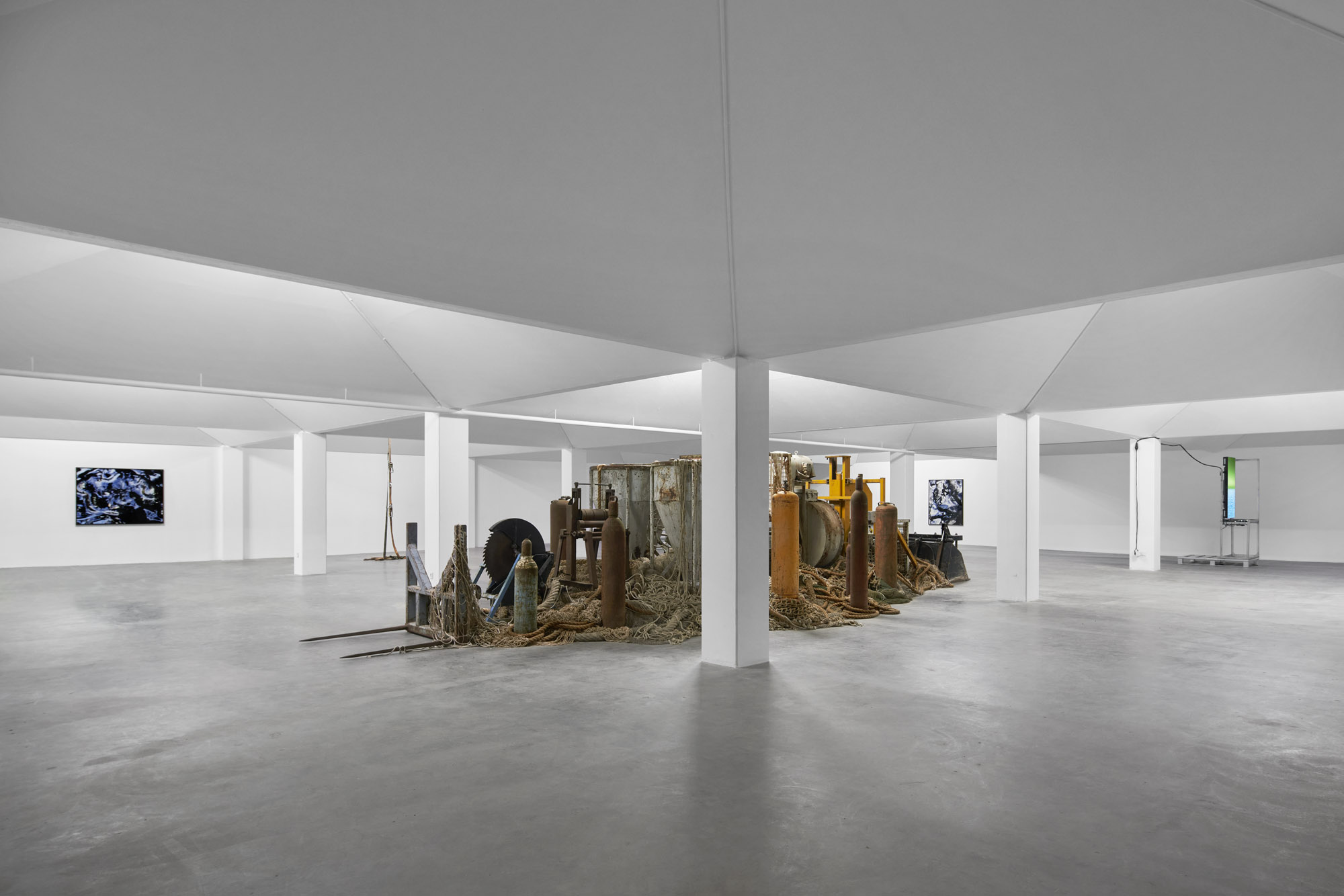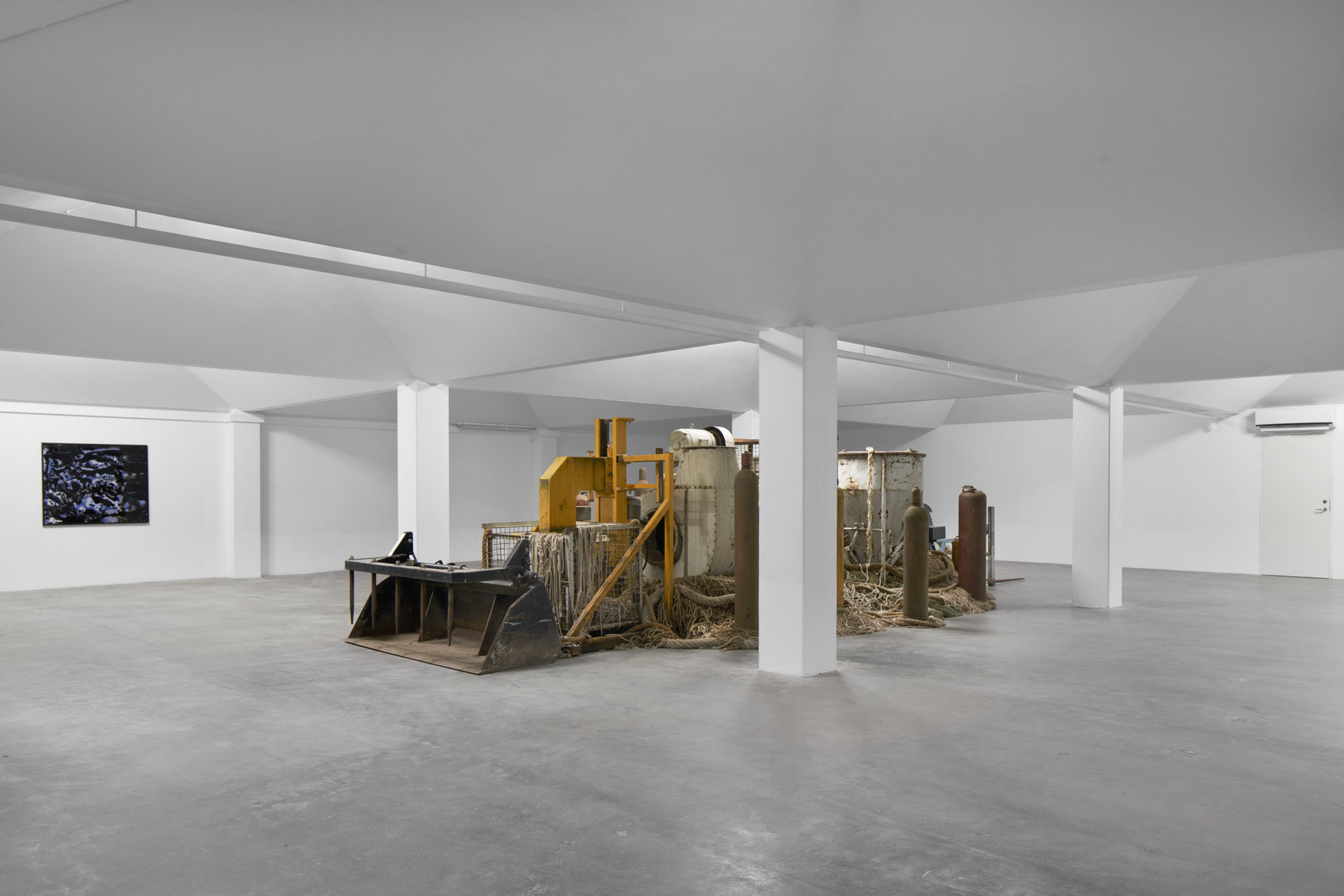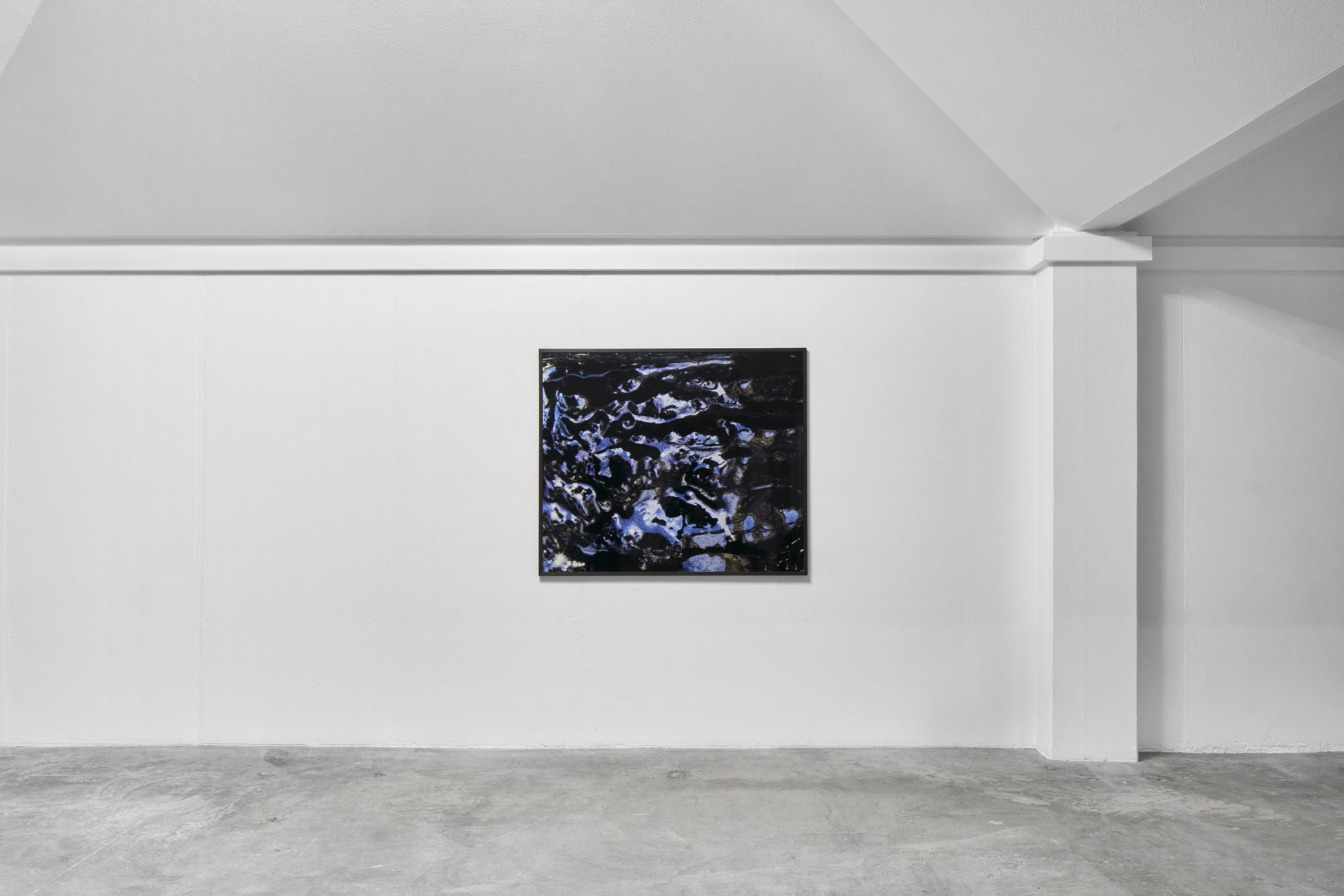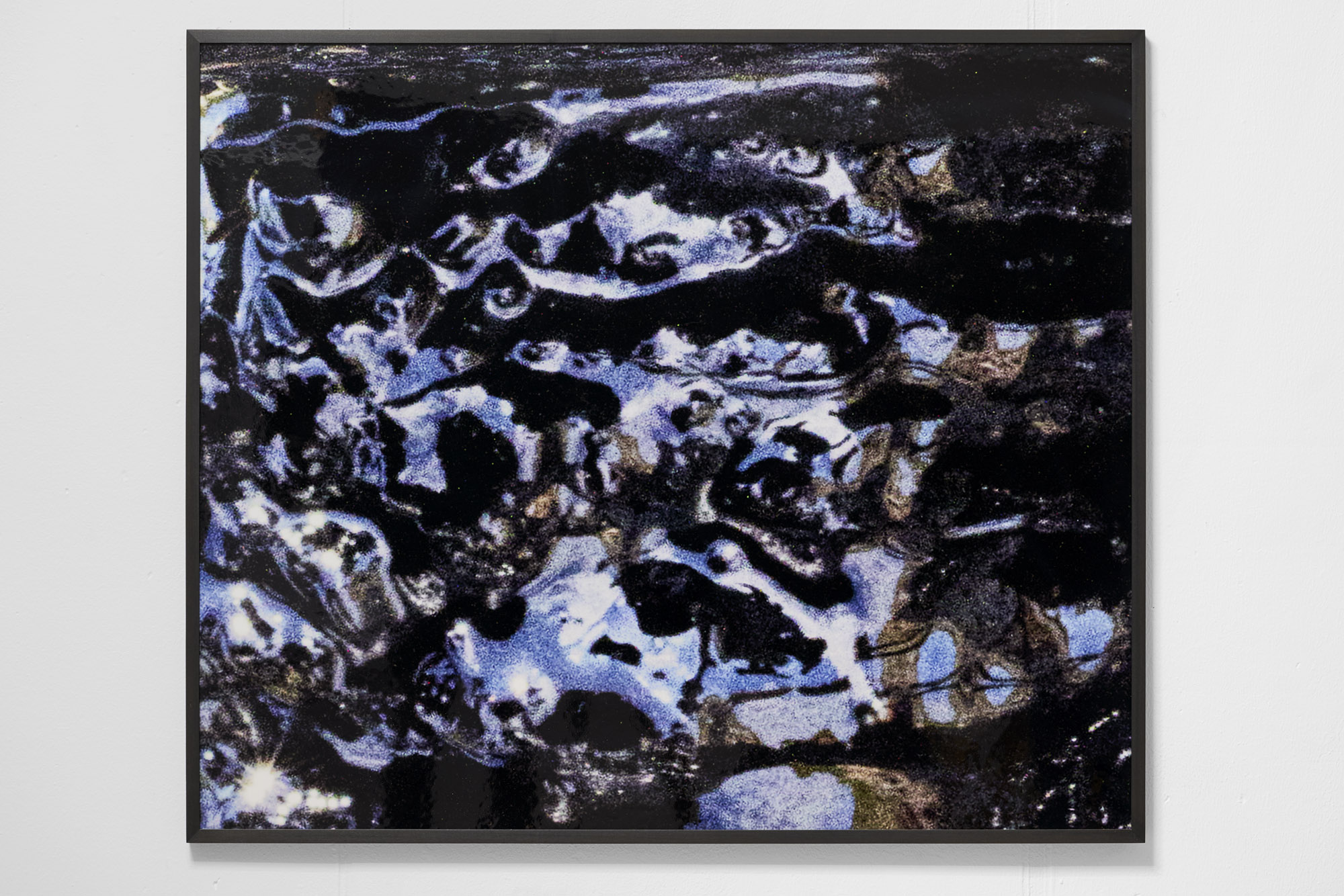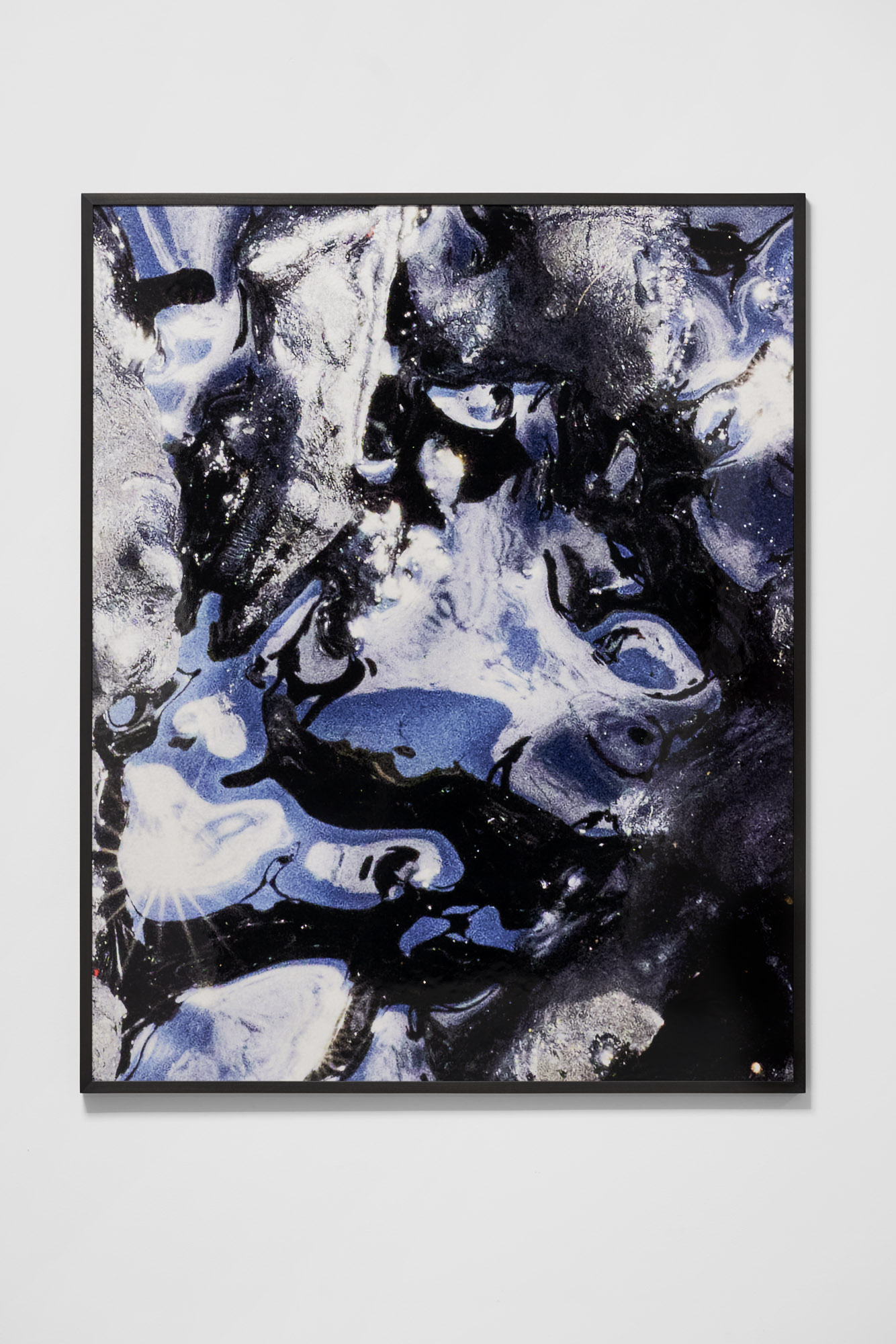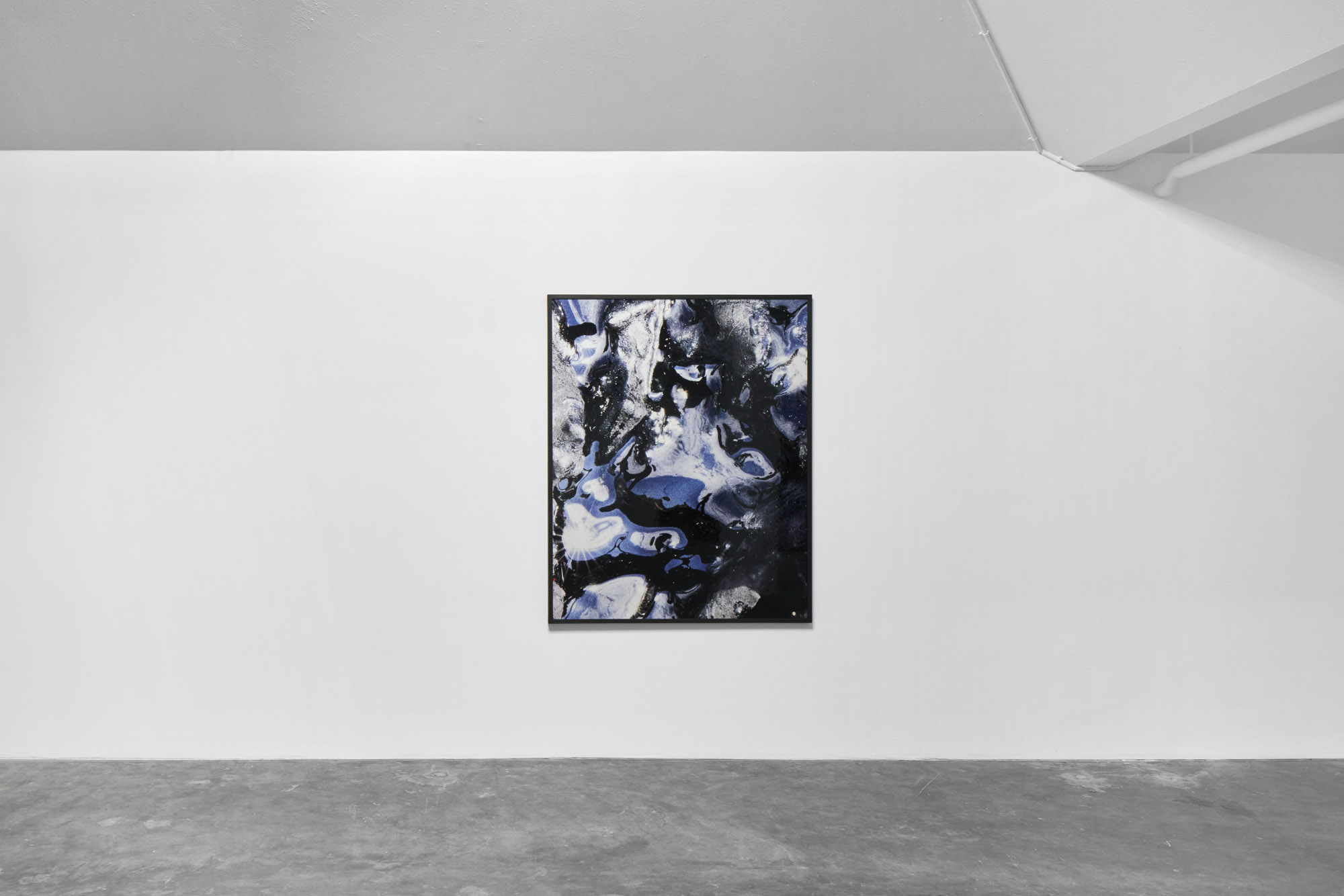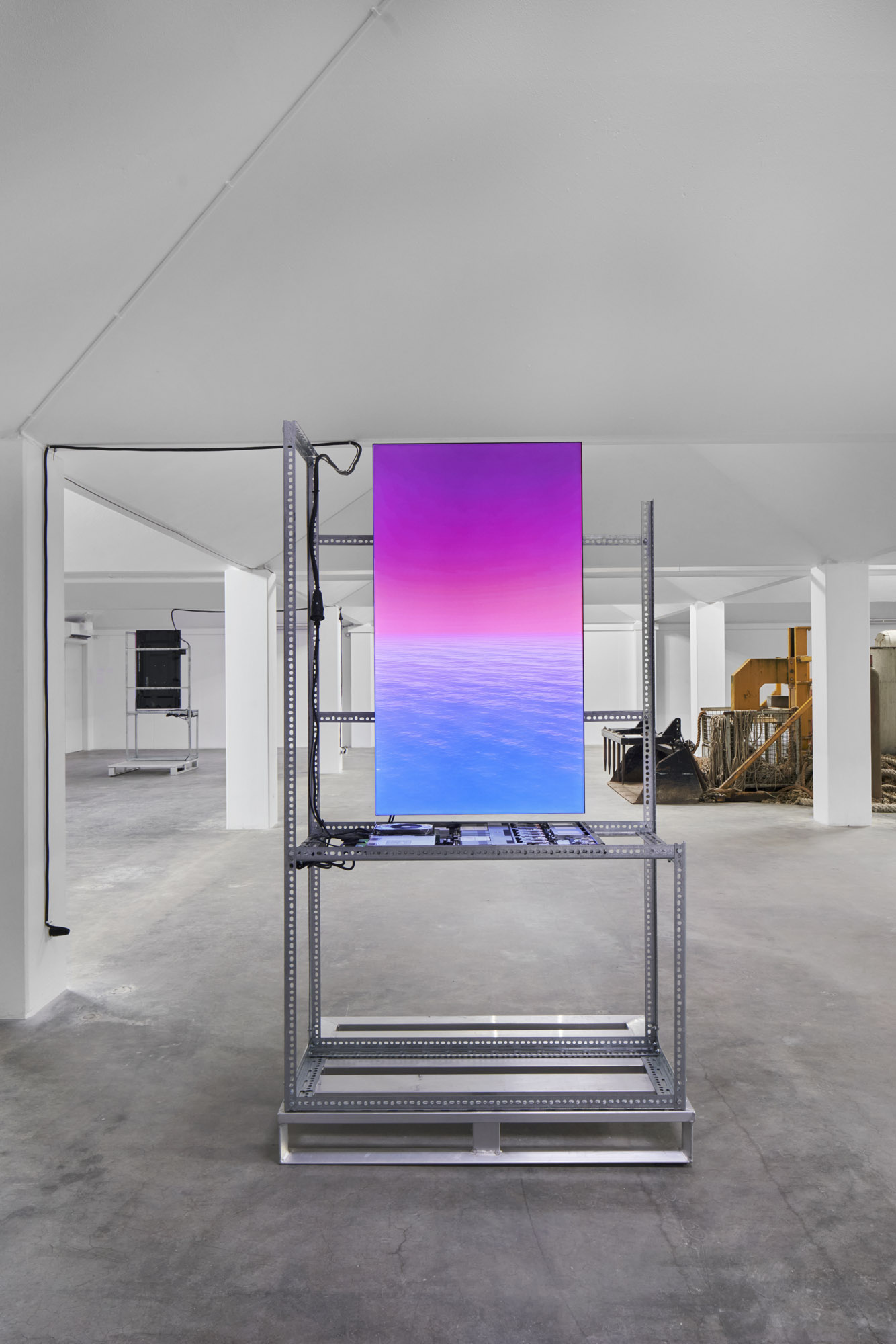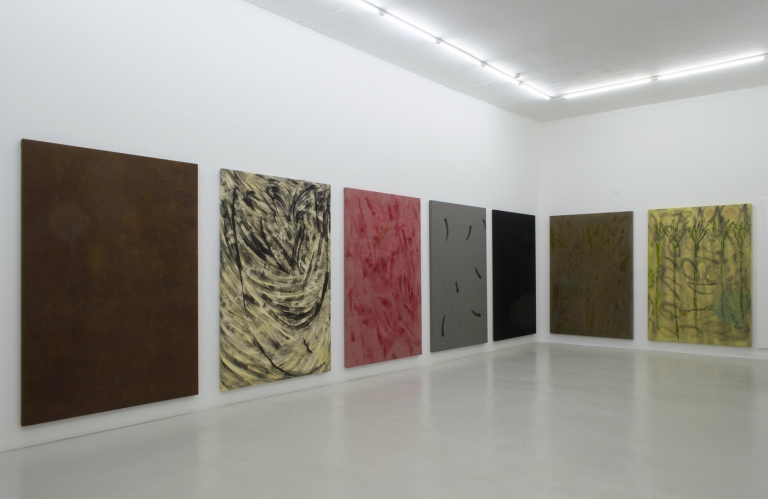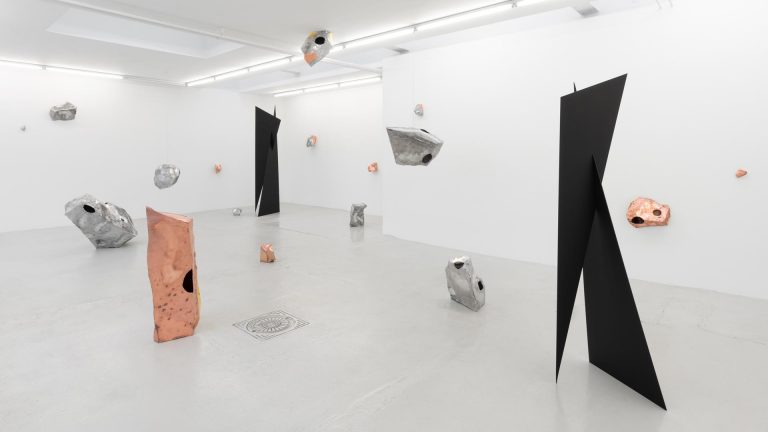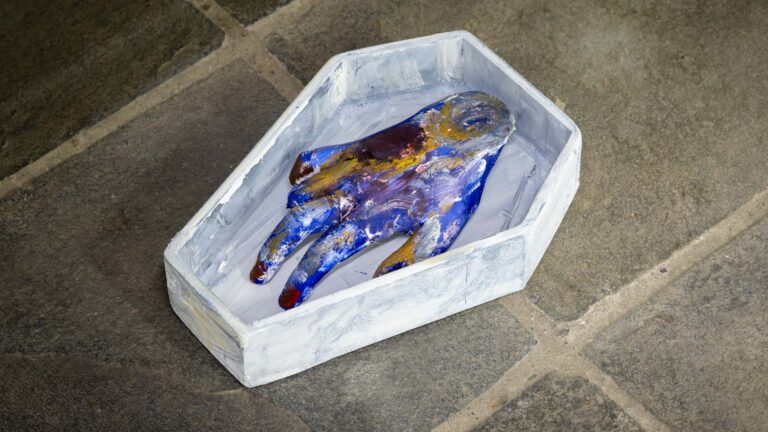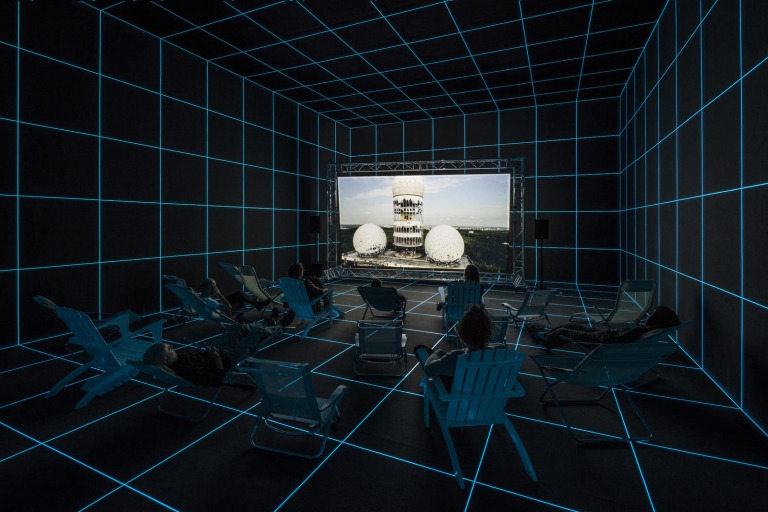Artists: Lucie Stahl, Yuri Pattison, Naïmé Perrette, Toke Flyvholm
Exhibition title: AMOUNT
Venue: Simian, Copenhagen, Denmark
Date: November 19, 2022 – January 15, 2023
Photography: GRAYSC / All images copyright and courtesy of the artists and Simian, Copenhagen
Note: Exhibition booklet is available here
“It’s after the end of the world, don’t you know that yet?” – Sun Ra
“Ruin is that which happens to the image from the moment of the first gaze.” – Jacques Derrida, Memoirs of the Blind
Given the accelerating collapse of our world, from environmental destruction to the corruption of our social, ecological, and political arrangements, it is hard not to embrace a sort of nihilist fatalism in the face of imminent disaster. Key to this state of paralysis is the incomprehensible scales of the problem and the failure of representing the convoluted geo- physical-eco-political dynamics that defy human perceptual experience. The philosopher Timothy Morton has famously applied the term “hyperobject” to such phenomena as climate change that are “massively distributed in time and space”, in which “gigantic scales are involved—or rather such knotty relationships between gigantic and intimate scales” that “the social and psychic tools we use to measure them” are utterly confounded.1The exhibition AMOUNT brings together works by four international artists—Lucie Stahl, Yuri Pattison, Naïmé Perrette and Toke Flyvholm—who each have addressed the (un)representability and (un)intelligibility of our hyper-mediated and moribund age in nuanced ways. Paramount to their diverse works is to reconsider logics of accumulation, excess, quantification, waste, and extractivism2 across human and more-than-human domains, thereby exposing corrupted ideologies not only at the heart of (techno)capitalism and the Anthropocene3, but also within certain environmentalist principles. The exhibition resists any grand pronouncements or solutions, rather it confronts a fractured state of visibility, representation, and perception amidst our crises. As the writer Irmgard Emmelhainz has asserted: “The Anthropocene has meant not a new image of the world, but rather a radical change in the conditions of visuality and the subsequent transformation of the world into images.”4 AMOUNT considers the political economy of such representations and how these are bound up in our social imaginaries and our material relations.
Endless accumulation, valuation, measurement, expenditure, exploitation, and extraction are the dominant operations of advanced capitalism, and are intertwined with the bifurcation of the world in metaphysics that separates and hierarchizes “nature” from culture, subject from object, life from non-life. Our environmental crisis demands that we confront these virulent logics by engaging with environments and materials on both micro and macro scales, and by showing geophysical phenomena as both planetary and situated, unthinkably vast yet proximate. But, like capitalism itself, it seems impossible to depict these inexorable dynamics in their totality, 5 and thus artists have a unique role to establish perceptual modes that could bring these themes into close, embodied proximity. Climate change has generated a range of representational techniques to consider the mass redistribution of material and the effects of these processes on local and global ecologies. Yet such images often follow a set of ideological tropes and abstractions. On the one hand, scientists account for this through simulations, numbers, and concentrations, often obscuring reality and relations with a mass proliferation of data that replicates the very extractive gaze at the heart of capitalism6. On the other hand, ecologists tend to compress these complex dynamics into a single picture, which either produces a “disastrous image” as a metonym for the larger whole (destroyed landscapes, suffering humans and animals, etc.), or aspires to a gestalt view that would give a sense of global unity and interconnection (“we are all in this together”, through images of the Earth or satellite views of territories). Both image conventions run the risk of reducing and universalizing our crises, neglecting uneven distributions and complicities, lingering in a state of destruction and tragedy that enables the co-optation by those who seek to profit from the catastrophe. To avoid this representational pitfall, the political theorist Jodi Dean has suggested that an “anamorphic gaze” can help break these habits:
“Anamorphosis designates an image or object that seems distorted when we look at it head on, but that appears clearly from another perspective. […] Apprehending what is significant, then, may require “escaping the fascination of the picture” by adopting another perspective—a partial or partisan perspective, the perspective of a part. From this partisan perspective, the whole will not appear as a whole. It will appear with a hole.”7
By confronting climate collapse askew, Dean suggests distorted perception as a countermeasure to the universalizing tendencies in both capitalism and ecological debates. In doing so, she argues for a situated and incomplete form of knowledge that would consider our multi-scalar and multi-temporal entanglements and complicities in our world, while also producing separations and openings from which critical thinking and action can emerge.
Yuri Pattison’s installation sun_set_provisioning (2020-2021) questions the visibility, depiction, and perception of our climate crisis, not only making visible (in)visible atmospheric threat(s), but also critically assessing what such attempts at representation makes intelligible. Supported by modular shelving and a litany of technical components, a pair of flatscreen monitors broadcast a constantly morphing image of an ocean sunset, which transforms according to the atmospheric conditions of the site where it is exhibited. The data feeding this visualization is via a uRADMonitor installed at Simian, which collects information from the immediate environmental surroundings and air quality conditions by measuring the presence of pollutants such as particulate matter (PM2.5, PM1, PM10), ozone, formaldehyde, carbon dioxide, and volatile organic compounds (VOC), as well as the temperature, barometric pressure, humidity, and noise within the site. The monitoring station is one of over 300 automated monitors around the world, which serve as independent first-line detection and warning systems for their communities, as well as form an interconnected global environmental surveillance network and publicly accessible live map. Scientific and policy making air monitoring devices tend to be opaque and black boxed, focused exclusively on gathering the most accurate and stable data in relation to human health. This invisibility is a problem, in that it reduces the possibilities for people to understand their influence on their milieu and sets humans at the centre rather than considering effects on non-human systems. By building a decentralized network for monitoring air quality, the developers and their citizen-agents seek to generate fully transparent and open climate data that is free from any manipulation or censorship from the “official” channels of the state and industry and, through this, bring urgent awareness of air pollution on a local and global level.8
A fusion of the exploitation of real-time data in techno-capitalism and the romantic wish to describe immediate reality, Pattison’s machinic assemblage translates this continuous data flux through an OpenGL game engine commonly used in the rendering of virtual environments to produce an endless animated image. On the screens, a gleaming sun rises and falls at an oceanic horizon, dispersing its rays across the undulating waves and hazy sky, never falling quite out of sight. The work not only makes the air whose quality is in question visible in situ, but also registers the very specificity of its site. Every variation in the image, from its subtle shifts in color to the movement of waves and the thickness of the atmosphere, are affected by the data values from the air quality monitor, registering the imminent environment in vibrant hues, including the effects of the viewer’s own presence. Yet there is a discordance between what is observed by the viewer and the mediated representation of that same information. Here, nature is estranged, a parallel reality only vaguely resembling our own. The beauty of the image obfuscates the dark reality that the toxic matter in our troposphere is indeed lingering with, around, and in us. Our bodies are permeable, we cannot escape this air, it flows into us through our lungs. The image is an intensification of this presence, it is the here and now in real-time. Thus, the seascape of Pattison’s installation is in fact a portrait of the viewer as much as their surroundings, an image of an invisible and suprasensible threat that is at once invasive and pervasive, intimate and global. sun_set_provisioning contests the notion of pollution as “out there”, this cultural reassurance that “we are the islands of inner purity in an ocean of environmental contamination.” 9 The constantly morphing view of the kaleidoscopic sunset exaggerates the fact that the spectacular sunsets we apprehend often only occur because of high amounts of pollution in the atmosphere. As such, Pattison’s virtual representation of the world is as artificial, technologized, and human made as its (un)natural counterpart. The visual reference to a Romantic sublime appears as an anachronism, where “nature” has receded, in the words of TJ Demos, “into a simulacral construction that is inextricable from human systems, becoming an effect of culture, economy, and technology.”10 Heightening the unseen conditions of our physical world, the implication here is that in our hyper- mediated experience, we may empathize more with this digital simulacrum than with reality itself. Even when we try to protect nature, we seem to only entangle the world even more intimately in human systems.
By way of anamorphic distortion and abstraction, the installation provides a view not unlike computer models through which infinite simulations are run to assess current and future climate scenarios. Yet by transforming ether into image, particles into pixels, and data values into tones, this synesthetic translation is ostensibly useless, too abstracted to extrapolate concrete data. Pattison has pointed out in interviews that most visualizations of air quality are themselves inconsistent, and laden with overly simplistic color coding that varies widely from place to place. As the artist notes, “This is one small example of the wider trend towards jargon data aesthetics where the visualization overwhelms the information it is professing to represent.”11 Just as the polychromatic sunsets of our polluted metropolises distract us from their cause and our own embedded complicities, the animated data is a sublime smokescreen that clouds our perception, a groundless and tautological form of seeing. By aestheticizing this data, we are anaesthetized to our crumbling reality, rendering our critically endangered environment into ambient entertainment akin to digital fireplace videos. Staring at a horizon with no ground with which to orient, we are trapped in a continuous twilight with no resolution, no nighttime, no pause, no end. Once, the “horizon” gave a sense of sublime expansiveness and gestured towards the unknown future, but just as the world is flattened in the image, the horizon is today only an abstraction, a representational artifact of a limited world. Our existential exhaustion and estrangement are exaggerated and extended into a nefariously endless loop of beginnings and ends, lingering at a spatial and temporal vanishing point.
The work’s title refers to legal clauses that set a date where a particular law will cease to be in effect, and the notion of “sunsetting” in the technology industry, where a company intentionally phases out or terminates a feature. It is a principle of auto-destruction, but also a stipulation that triggers change and reanalysis. The installation suggests an urgent need to establish a “sunset provision” for our current structures, and initiate new frameworks, new beginnings. Rather than address this situation from outside, Pattison emphasizes that his installation is also implicated in the destructive system it represents. It includes the same industry-standard data center servers that support our digital economy and uses gaming GPUs that are commonly used for the energy-sucking and fossil-fueled mining of cryptocurrencies. Perhaps this is also why the artist presents the digital image on flatscreens in a manner reminiscent of advertising and corporate displays and has mounted the assemblage on slotted angle steel strip shelving that is ubiquitous in not only server farms and data mines, but also regularly used in disaster relief efforts. The crisis that this mechanism responds to is not only an environmental nor only a perceptual one, but also a crisis of infrastructure and agency, a failure of being able to imagine and construct solutions outside our cataclysmic economic and social arrangements. Pattison embeds his work in the complexities and contradictions of this material present, calling for an end to our current system, and drawing attention to new forms of survival and organization in this state of crisis.
The groundlessness of Pattison’s visualization can be compared to the progressive destabilization of the physical ground in Naïmé Perrette’s film Both Ears To The Ground (2021), which explores the social, cultural, and ecological environment of Berezniki, Russia, an industrial city in the Ural mountains that has become infamous for its massive sinkholes caused by mining. Berezniki lies on the Verkhnekamsk deposit of potassium-magnesium salts and most of the city’s residential buildings are located directly above the mines.12 In the last decades, these mines have increasingly flooded, eroding their soluble mineral supports and leading to collapses of the earth in the form of large sinkholes across the city. The city is literally losing ground and its water has become toxic and briny. Though these sinkholes have become sensational images for foreign journalists, for the citizens of Berezniki who largely work in the mines, they are simple facts of existence which have become so commonplace and normalized that the locals have given each familiar nicknames such as “the grandfather,” “big brother,” and “distant relative”. By interweaving this state of extraction, labour, and environmental collapse with forms of communal conviviality and survival, Perrette avoids the trope of the disastrous image and instead focuses on the human and non-human entanglements and conflicts in this intermingling of industry and culture.
One of the principal problems in studying human bioturbation or “anthroturbation”—the large-scale modification of the geologic structure of the earth via boreholes and mines—is that “the extent and geological significance of subsurface crustal modifications are commonly neglected: out of sight, out of mind.”13 A moment where the underground becomes blatantly visible, the sinkholes are not only a rupture in the physical fabric of the city, but a fracturing of notions of temporality, agency, and visibility, bringing into contact geology and biology. As Perrette has noted, “Sinkholes are a combination of human and natural processes, a rapid breaking point of slow movements happening out of sight, a conflict between spectacular occurrences and invisible dynamics.”14 In a series of almost phantasmagorical sequences, the artist and filmmaker ventures deep into the permeable and fractured spaces of the underground mines, exposing the variegated strata lining the bore holes and paths underneath the city, as well as the monstrous machines churning up material for industry. Amidst clouds of mineral dust contaminating their porous bodies, workers labour to extract salt15 and potash, which is used in fertilizers for industrial agriculture and comprises 10-20% of the global market. The continuing extraction of this material is indeed the result of what Karl Marx referred to as a “metabolic rift”16, where the over-extraction of nutrients from the soil has necessitated the constant accumulation of resources to serve as a supplement. Here, extraction is shown to produce rearrangements of matter that disfigure other organic and non-organic arrangements, such as bodies and land.
Perrette’s film approaches the sinkholes in an oblique way by frequently shifting her view from the mine to the everyday life of Berezniki’s inhabitants, occupying a different perspective from the sensationalist images in the media. Annoyed by the attention that the sinkholes have gotten, the people here do not embrace the doom and nihilism that such holes of oblivion propagate, instead they have an overall sense of optimism and routine. In addition to interviews with city residents and workers in the mines, a significant amount of attention is given to a local theatre troupe, whose role in the past and present has been to entertain the mine workers. Here, Perrette’s critical artistic investigation of the depiction of this place meets the notion of art as a refuge and momentary escape from our (ecopolitical) realities. The artist temporarily embedded herself into their community, and her presence not only became fodder for a local news report, but also was incorporated into the drama on stage. This logic of the artist as an implicated witness reaches its apotheosis in a scene at an after-rehearsal gathering, where one of the players explains to another: “He plays the role of a filmmaker and she’s a filmmaker filming the rehearsal of their play about the filmmaker who’s coming to the city to film a play rehearsal.” The almost fractal ramifications of this simulacral statement within the film affirms that the work is primarily concerned with the representation of the representation of the city, its sinkholes, and its inhabitants, rather than functioning as a straight-forward journalistic and disengaged documentary. One cannot help but marvel at the resilience of the people as the ground is literally and figuratively falling from under their feet. At the same time, their lack of concern is worrying yet familiar. Like us all, they are trying to persist amidst an increasingly impending crisis and cannot envision their lives any other way. Perrette avoids any moralizations regarding the people or the mines, focusing on the gaps in their relationship.
Presented within the massive cave-like hole of Simian, the film juxtaposes these realities to not only correspond events at the surface with the subterrain, but also to reveal this inherent separation, this fracturing of corporeal and mental capacities even in the face of palpable realities. The seemingly stable groundedness of our world caves in. The holes in the Earth correlate with the porosity of the bodies of the miners. The appearance of sinkholes, while being directly caused by anthropogenic changes to the geology of the area, itself directly interferes in the possibility of ongoing habitation and extraction. A local miner states in the film that he prefers to “move forward” and that “movement is life”, but we can also recognize that he is literally digging up the past and annihilating the future in this extraction, and that both life and the inorganic are at risk from this vocation. Berezniki’s sinkholes attest to the reality that the dark mines can no longer be regarded as inert grounds from which to accumulate resources, but instead operate as active forces that resist and (re)organize surface conditions. Rather than provide a simple and seamless thesis, Perrette’s film emphasizes the frictions and fractures between human and geological worlds and their spatial and temporal scales, dwelling in what Anna Tsing describes as “the sticky materiality of practical encounters,”17 to resist the spectacle of our contemporary “anthroposcenery”18.
Images of the human despoliation of the earth have become so commonplace that they are now fetishized and serve as spaces where our imaginations run wild. Nowhere is this more apparent than in Lucie Stahl’s series Burrows (2022), which features close-up photographs of murky petro-puddles from an abandoned oil field in Qark Fier, Albania. Oil is the lubricant and fuel of capital, an icon for the logic of extraction and the eradication of life. But rather than depict this oozing disposition in its local context à la conventional reportage or as a metonym for the hyperobject that is climate catastrophe, Stahl deploys an anamorphic gaze, defamiliarizing the toxic sludge by focusing on its details and providing a partial, situated, and estranged perspective. Pointing her camera down to the earth like a drone or microscope, the artist zooms into this crude, base materiality, coming so close as to be stuck in the goo. The resulting all-over compositions have been printed on heavyweight textured etching paper that lends the images added depth and materiality akin to frottage drawings. Like the sticky substance in the images themselves, the ink burrows into the textured field of the paper, smearing the surface in a radiant darkness. The strange visuality of these close-up photographs, their seeming artificiality and uncanny proximity, annihilates any hope for critical distance, and confuses the notion that getting closer to something leads to further understanding, leaving us dumfounded in a viscous void.
The percolating presence of the muddy, and almost fecal, fossil fuel in the photographs calls forth a sense of a foreboding unknown, an incomprehensible abyss. Face to face with the formless, the human observer cannot help but call upon the habit of apophenia to try to discern recognizable forms in the murky muck. Like an ink blot, the oil is a substance for fantasies and projections. Yet, within the oil’s iridescent sheen one can identify what appear to be sunspots or camera flashes and distorted reflections and refractions of the world around. The effect is reminiscent of the proto-photographic Claude glass, a tinted black mirror carried by 18th century artists, naturalists, and travellers to soften and reduce “natural” scenery into a painterly image. Like pictorialist photographers who would smear their lenses with petroleum jelly to give their images a painterly quality, this dark material softens and obscures as it reveals, while also giving the images increased melodrama. Just as petroleum has seeped into every aspect of our realities, we now view the world through the sticky medium of the photographic.
Both photography and capital are linked to possession. They both possess what Karl Marx called “the property of appropriating all objects”19. Photography and oil are shown to share a logic of capture and abstraction that underpins the history of capitalism and industrialization. Both oil and images work as grease for our corrupted social arrangements, which seeps into our apprehension of the “natural world” like a venomous symbiote. The oil seizes the world into its orbit, distorting its image, operating like a black hole pulling the universe into its void. The base materiality of the photographs of oily puddles recalls the black highly viscous goo of Bitumen of Judea, a light-sensitive petroleum asphalt used to produce the earliest photographs, and likewise points to all the other noxious elements in photography’s history, from deadly mercury fumes, gooey gelatine, and toxic chemical baths to the rare earth elements mined for our digital cameras. Photography today has largely been separated from its chemical materiality, and thus the indexicality that connects the image to its referent in the physical world, supplanting the “wetness” of its chemical processes with the seemingly “dry” and dematerialized routines of automation, computation, and redundancy. Stahl’s gooey pictures stick to this logic of the indexical, while also charting its progressive dissolution and the muddying of reference. Like the notion of the photograph as indexical evidence, toxic discharges seeping upwards from the ground are regarded by geologists and petro-capitalists as indicators for “proven” reserves below. Yet the filthy fields depicted in the images are “over-developed” and “over-exposed”, constituting an afterimage, a trace of hydrocarbon extraction that has left volatile waste at every scale of the landscape.
The erotic and sensual charge of the close-up images is derived from this indexicality, this scientific will-to-knowledge that needs to render visible hidden secrets as evidence and get as close to its subject as possible. The obscene tactility, perverse partiality, and flagrant matter-of-factness of the photographs follows a “principle of maximum visibility” 20 where bodily discharges are treated as visible indexes for pleasure, which the feminist author Linda Williams described as conventional hard-core pornography’s defining modus operandi. By repeating and focusing closely on these out-of-control oily excretions, Stahl generates a “frenzy of the visible” that conflates visual and tactile pleasure with danger by eradicating any distance that would allow the spectator to critically, morally, politically, or aesthetically reflect on the images that are in front of them. For the petro-capitalist, the images literally represent a “money shot”, a pleasurable, excessively visible, profusion of viscid value. Recently, the artist and researcher Madeleine Andersson has proposed the term “petrosexuality” to characterize these psycho-sexual underpinnings of fossil fuel extraction, asserting that the disastrous consequences of global energy systems cannot be understood without attention to logics of desire, lust, and power that fuel a ravenous appetite to penetrate, extract, and burn.21 Stahl’s photographs exaggerate the erotic and extractive excitement and (world-annihilating) pleasure of the oily leaks and petro-secretions by affirming an intimacy with the seeping crude. In depicting this uncontrollable eruption from below, the artist charts a libidinal economy of waste and consumption, abundance and scarcity, that ties our bodies and desires to the extractivist urge to dig up, burn, destroy, and sacrifice the Earth.
“Death is the eidos of the Photograph”22, says Roland Barthes, they are witnesses to moments that are no longer, and upon every viewing, the dead presents itself to the viewer. Stahl’s images of petro-waste represent the confused temporality in this cycle of death and rejuvenation, this gathering of the past as a weapon against the future. The strange substance of petroleum is a subterranean and anachronistic agent of history whose “essence” is also death, both as the reanimated remnants of a world long gone and an inhuman force that marks the demise of life as we know it. It is the undead substance of “fossil futures and future fossils”23, a multidimensional and vicious vector distorting timescale.
A further mediation on extractivism, death, and futurity, Toke Flyvholm’s new installation Caretaker (2022) is a dormant giant comprised of a wide range of industrial components and machines displaced from their use. Chosen for how their material presence imposes itself on the viewer, each object is estranged from their context and collected to form a disjointed body, calling attention to the relation between human scale and the machines we deploy to conform the world to our destructive ambitions. Like a clumsy archaeologist arranging fossilized fragments of an unknown creature, Flyvholm conjoins the wreckage of industry according to an improvised anatomical system. Fragmentary, uncertain, and frightening, the scavenged conglomeration is a man-made monster, a creature of Frankenstein cobbled together with dead parts that are reanimated anew. Affirming this state of horror, the enormous metallic instruments form a scrappy framework akin to a skeleton, with bulky ropes and nets alluding to intestinal guts and capillaries, which literally and figuratively tie the construction together. It is a body without clear organization, but a body, nonetheless. The assemblage gives the impression of a giant cadaver of a beached whale or the excavated remains of prehistoric woolly mammoth that is frozen in a state between composition and decomposition.
The “head” of this monstrous contraption features the bucket of an excavator, that menacing heavy construction tool used to handle material in bulk, clearing the land, pushing around the Earth, carrying it from place to place, and collecting raw substances into piles. One cannot help but attribute zoomorphic associations to this front-end loader blade, it is the quintessential component of a bulldozer, the lumbering horns ushering in industry. Some may be surprised to learn that the American English word “bulldozer” initially meant a large “dose” (namely, one large enough to be literally effective against a bull), but then came to be used to describe violent tactics of intimidation or coercion against African American voters in the American South. It was only later that “bulldozing” would be used to describe using brute force to push over or through any obstacle, with reference to two bulls pushing against each other’s heads in a fight over dominance. Given the inextricable entanglement of extractivism with racialized capitalism and colonialism, this tool, at the frontline of any uprooting campaign, somehow maintains these racial, animal, narcotic, and violent associations despite its normalization as a key instrument in development and extraction.
Above all, Flyvholm’s assemblage is a cluster of verbs, an inventory of infrastructural elements, an aggregation of actions in a state of arrest. Close inspection of the disparate parts yields numerous speculations on their functions and their respective industries. But together, a common strain runs through all the components in the alienated aggregate: the primary purpose of each element is to accumulate, extract, demolish, and displace, thus illustrating the extractivist logics of capitalism through the technical components at its base. What remains is a bundle of geopolitical technologies, a machinic vector that works across scales and territories to extract as much value as possible by bridging human and non- human domains. Yet it is precisely these objects’ persistence in our world, and our inability to draw a direct line between their operations and our current geopolitical and ecological disaster, that gives the assemblage its dark and daunting distinctiveness. Decommissioned, dismantled, and reduced to heterogenous scraps, one could easily attribute the composition to the perfunctory gathering principles of a metal wrecking yard or trash pile. Yet the collection seems to imply a whole akin to Rube-Goldberg-like assembly line whose product may be hidden but is nonetheless suggested, as opaque, obscure, and mysterious as any other machine an untrained viewer may encounter. Surely an expert of one field or another could appraise each object’s possibility to have their value recouped or recycled into another domain. We expect these machines to work for us, to be extensions of human hands and intentions, but the inoperative and disjointed condition of the sculptural contraption denies any possible utility and instrumentalization. There is no contrived whole, only gaps in a productive urge. The arrangement of abandoned industrial flotsam and jetsam forms its own internal logic that is at once aesthetically motivated and completely removed from human expectations and desires. By dislodging the industrial machines and components from not only their circulation but also their essential ontology, new relations are formed between the implements. As emancipatory and anti-anthropocentric as this notion may seem, this indeed is what capitalism has long strived for: to take human labour out of the equation, and let commodities generate value ad infinitum on their own.
As if signifying the day after the machines have stopped churning, a hopeful viewer could imagine the liberal recycling of these elements, that they would somehow be rendered obsolete in the transition to a “green economy” and therefore could be reimagined, recast, and recuperated by art in light of a new ecological ethics. The implication here is that long after humans are gone, the tools used in our planetary excavations will remain and become fossilized artifacts to be discovered and interpreted anew. But these artifacts do not belong to the memory of a past. Instead, they constitute a dark future. Flyvholm’s inventory marks the vanishing of the human from the scene, a menacing image of our world rising into ruin. We are haunted by a future that bears our death, the disintegration of our world.
AMOUNT provides a set of artistic accounts that envision the present through an increasingly apocalyptic disposition, producing an image of the “final hour” that is not merely a prediction regarding the world’s wretched future, but also in the etymological sense of “unveiling,” a cataclysmic state where the world is received and revealed. The theologian Jean-Luc Marion argued that in apocalypse, what is experienced is saturated with meaning, so that one is no longer a neutral observer, and perspective is inverted, inducing an “overturning of the entire phenomenal arrangement: the movement into a complete anamorphosis”.24 The overwhelming moment of existential crisis instigates a shift in view, a radical estrangement and displacement, an attunement to the world where one no longer can grasp it from a single view or as a whole, but as a series of holes in perception. Radically subjectivizing reality, it is the moment where the crumbling world looks back at us, where the observer is already inscribed in their milieu. Through this cognitive estrangement, the distorted anamorphic gaze lays havoc to fundamental elements and principles by asserting the presence of the unimaginable, and revealing that reality is contingent, inadequate, and ideological, and thus can be altered. By abstracting the world and approaching it askew, reality “as it is” crumbles and fractures. Jodi Dean speculates that such a repositioning could help dislodge us from this almost universal feeling of melancholy in the face of the immensity of our environmental collapse.25 Under the bewildering weight of climate change, we rationalize, quantify, and try to “see the big picture”, leaving us with an image representing all or nothing. Dean warns us that this captivation and fetishization of complexity, of a whole with us at the center, follows the same ideological habits of capitalist extraction, accounting, and hyper-mediation that renders reality into an incomprehensible image. By weaponizing an apocalyptic and anamorphic view to confront the end of the world, we paradoxically bring about “the end of the aesthetic idea of ‘world’ as an environing, distancing and distanced horizon,”26 and thus can begin to imagine new forms of engagement and exchange.
“The true world is gone: which world is left? The illusory one, perhaps? But no! We got rid of the illusory world along with the true one!” – Friedrich Nietzsche, How the ‘True World’ Finally Became a Fable, in Twilight of the Idols, or, How to Philosophize with a Hammer.
– By Post Brothers
1 Timothy Morton, Hyperobjects: Philosophy and Ecology after the End of the World (Minneapolis: University of Minnesota Press, 2013), 1, 47. 2 “According to theorists Sandro Mezzadra and Brett Neilson, extractivism identifies both historical and current modes of wealth accumulation based upon the withdrawal of raw materials and life forms from the planet’s surface, depths, and biosphere in the production of financial value, which run in coordination with expansive politico-economic and socio-technological systems pledged to its operations.” TJ Demos, Blackout: The Necropolitics of Extraction(Dispatches #000, 2018). 3 The Anthropocene is the geological era in which humans play the primary role in the geological and ecological makeup of the planet. Though this mode of thinking offers a recognition of human responsibility, it also has a problematic tendency to further colonize the Earth by placing the human at the centre of all relations. 4 Irmgard Emmelhainz, Conditions of Visuality Under the Anthropocene and Images of the Anthropocene to Come (E-Flux Journal Issue #63, March 2015). 5 Fredric Jameson notes the impossibility of directly representing the totality of global capitalism, “in which the informing power is everywhere and nowhere all at once, and at the same time in relentless expansion, by way of appropriation and subsumption alike.” Fredric Jameson, Representing Capital (Verso, 2011), 7. 6 A “progressive and acquisitive gaze that perceives the world as a reservoir of potential value to be extracted and accumulated.” Onur Ulas Ince, Colonial Capitalism and the Dilemmas of Liberalism (Oxford University Press, 2018), 54. 7 Jodi Dean, The Anamorphic Politics of Climate Change (E-Flux Journal Issue #69, January 2016). 8 It is only when you feel the repercussions of your own action that you understand to what extent you are responsible for it. As Peter Sloterdijk has noted, it is only when humans see pollution falling back on them that they begin really to feel that the Earth is in fact round. Nevertheless, this logic of an almost-libertarian independence and autonomy curiously replicates the valorization of personal responsibility that has long served as a smokescreen preventing infrastructural real climate action by displacing the burden from the state and industry to the individual consumer. 9 Michael Marder, Being Dumped, (Environmental Humanities 11:1, 2019), 180–193. 10 TJ Demos, Photography at the end of the World (IMAGE [&] NARRATIVE Vol. 16, No. 1, 2015). 11 Yuri Pattison in conversation with Bart van der Heide (CURA.36, 2021). 12 Berezniki, like so many other small Russian industrial cities, began its existence as a Gulag. Soviet policy required camps to be placed within marching distance of where prisoners worked. The city was thus built directly over a potash mine, some 300 metres below ground level. 13 Zalasiewicz et al., Human bioturbation, and the subterranean landscape of the Anthropocene (Anthropocene Volume 6, 2014), 3. 14 Naïmé Perrette, artist statement, Both Ears To The Ground (2021). 15 Viewed from our current perspective, the excess and over-abundance of salt is a brackish and bitter image: one of the first targets of Russia’s ecocidal and genocidal invasion of Ukraine was its main salt mine and factory, leaving Ukrainians today with only the salt of their tears. This fact was shared with me by the Ukrainian artist Yaryna Shumska, who has dealt with this substitution in some of her recent performances. 16 “The Anthropocene is a series of metabolic rifts, where one molecule after another is extracted by labour and technique to make things for humans, but the waste products don’t return so that the cycle can renew itself. The soils deplete, the seas recede, the climate alters, the gyre widens: a world on fire.” McKenzie Wark, Molecular Red(Verso, 2016), XIV. 17 Anna Lowenhaupt Tsing, Friction: An Ethnography of Global Connection (Princeton, NJ: Princeton University Press, 2004), 1. 18 Karl Schoonover, Sinkholes, GIFS, and cinematic ecologies (Journal of Cinema and Media Studies, Vol. 58, Issue 2, 2021). 20 Karl Marx, The Power of Money, in Early Writings, trans. by Rodney Livingstone and Gregory Benton (London: Penguin Classics, 1992). 21 Linda Williams, Hard Core: Power, Pleasure, and the ‘Frenzy of the Visible’ (University of California Press, 1999). 21 Madeleine Andersson, Petrosexuality – a publication (self-published, 2022). 22 Roland Barthes, Camera Lucida, trans. by Richard Howard (New York: Hill and Wang, 1981). 23 Jussi Parikka, A Geology of Media (U. Minnesota Press, 2015). 24 Jean-Luc Marion, Givenness and Revelation, trans. Stephen E. Lewis (Oxford University Press UK, 2016), 108. 25 Jodi Dean, The Anamorphic Politics of Climate Change (E-Flux Journal Issue #69, January 2016). 26 Timothy Morton, Zero Landscapes in the Time of Hyperobject, (Graz Architectural Magazine 7, 2011), 87.
AMOUNT, 2022, exhibition view, Simian, Copenhagen
Naïmé Perrette, Both Ears To The Ground, 2021, Digital video, 29:00 min
Naïmé Perrette, Both Ears To The Ground, 2021, Digital video, 29:00 min
Naïmé Perrette, Both Ears To The Ground, 2021, Digital video, 29:00 min
Naïmé Perrette, Both Ears To The Ground, 2021, Digital video, 29:00 min
AMOUNT, 2022, exhibition view, Simian, Copenhagen
AMOUNT, 2022, exhibition view, Simian, Copenhagen
AMOUNT, 2022, exhibition view, Simian, Copenhagen
AMOUNT, 2022, exhibition view, Simian, Copenhagen
Lucie Stahl, Burrows (5), 2022, inkjet print, aluminium
Lucie Stahl, Burrows (4), 2022, inkjet print, aluminium
Lucie Stahl, Burrows (3), 2022, inkjet print, aluminium
Toke Flyvholm, Untitled, 2022, Straps
Toke Flyvholm, Untitled, 2022, Straps
Toke Flyvholm, Caretaker, 2022, Mixed media
Toke Flyvholm, Caretaker, 2022, Mixed media
Toke Flyvholm, Caretaker, 2022, Mixed media
Toke Flyvholm, Caretaker, 2022, Mixed media
Toke Flyvholm, Caretaker, 2022, Mixed media
Toke Flyvholm, Caretaker, 2022, Mixed media
AMOUNT, 2022, exhibition view, Simian, Copenhagen
AMOUNT, 2022, exhibition view, Simian, Copenhagen
Lucie Stahl, Burrows (6), 2022, inkjet print, aluminium
Lucie Stahl, Burrows (6), 2022, inkjet print, aluminium
Lucie Stahl, Burrows (2), 2022, inkjet print, aluminium
Lucie Stahl, Burrows (2), 2022, inkjet print, aluminium
Yuri Pattison, sun_set pro_vision ~ east, 2020 — 2021, Vulkan game engine software, modified Dell PowerEdge R620, GeForce GTX 1650 GPU, uRADMonitor MODEL A3 atmospheric monitor, HD digital signage monitor, Dexion slotted angle, aluminium EUR pallet, cables, data, particulate Matter (PM2.5, PM1, PM10), Ozone, Formaldehyde, Carbon Dioxide, Volatile Organic Compounds (VOC), temperature, barometric pressure, air humidity and noise
AMOUNT, 2022, exhibition view, Simian, Copenhagen
Yuri Pattison, sun_set pro_vision ~ east, 2020 — 2021, Vulkan game engine software, modified Dell PowerEdge R620, GeForce GTX 1650 GPU, uRADMonitor MODEL A3 atmospheric monitor, HD digital signage monitor, Dexion slotted angle, aluminium EUR pallet, cables, data, particulate Matter (PM2.5, PM1, PM10), Ozone, Formaldehyde, Carbon Dioxide, Volatile Organic Compounds (VOC), temperature, barometric pressure, air humidity and noise
AMOUNT, 2022, exhibition view, Simian, Copenhagen

